Vietnam Travel Inquiry Contact us
- Transportation
- Vietnam Destinations
- Cambodia Destinations
- Laos Destinations
- Myanmar Destinations
- Thailand Destinations
- Vietnam Tours
- Indochina Tours
- Cambodia Tours
- Thailand Tours
- Myanmar Tours
- Vietnam Travel Guide
- Cambodia Travel Guide
- Laos Travel Guide
- Myanmar Travel Guide
- Thailand Travel Guide
- Indochina Travel Guide
- Vietnam and Cambodia travel guide
- Southeast Asia Travel Guide
- Vietnam Hotels
- Cambodia Hotels
- Laos Hotels
- Myanmar Hotels
- Thailand Hotels
- Testimonials
- Vietnam tours
- Indochina tours
- Cambodia tours
- Myanmar tours
- Thailand tours
- Vietnam destinations
- Cambodia destinations
- Laos destinations
- Myanmar destinations
- Thailand destinations
- Vietnam hotels
- Cambodia hotels
- Laos hotels
- Myanmar hotels
- Thailand hotels
- Vietnam travel guide
- Cambodia travel guide
- Laos travel guide
- Myanmar travel guide
- Thailand travel guide
- Indochina travel guide
Vietnam is a country that is relatively safe for tourists, but similar to most major cities there is the risk of traveller annoyances, such as petty crime and scams.
Here are a few of the scams and tourist traps to be aware of to better enjoy the safe and awesome trip:
Overview It is a good idea to inspect goods purchased, especially electronics. A typical scam includes switching out the original item you intended to purchase for a cheaper version.
While the official currency is the Vietnamese dong, there are plenty of places such as transportation, hotels and eateries that are quoted in USD. So, make sure you are aware of the currency before agreeing to buy or use a service. For instance, a trader that tells you the price is "five" could mean US $5 or 5,000 dong (about 22 cents).
Motorbike bag snatching and pickpockets – especially in Nha Trang, Hanoi and Ho Chi Minh City – are on the rise. Personal injuries are avoided in these situations by letting the bag go.
Transport Travellers on the Vietnam family tour may encounter illegal taxi drivers that try to trick foreign customers using several different methods. A common technique is to use the modified meter which will run a lot faster than normal leading to higher than expected rates. Also, they will travel the longer routes to further increase the rates.
A simple solution to avoid most of the taxi scams is to use one of the trustworthy brands, such as Vinasun or Mai Linh. You should be able to recognise these taxis by their logos and colours.
A local form of transport is the Xe Om (motorcycle-taxi) and popular with tourists. To avoid high fees when travelling in town, it is practical to negotiate the rates before getting in the xe om. Some drivers of these vehicles will over inflate their rates if it is left until arriving at your destination.
Bag Snatchers Crime in Vietnam is relatively low, but similar to travelling in any popular tourist destination in the world; you need to be mindful of your personal belongings. Try to avoid dangling your bag from your body because it could easily attract the attention of the drive-by snatchers. It is more practical to leave values in the hotel safe when out travelling around to minimize this type of problem. But, in the event of coming across a snatcher, you will be more willing to let the bag go with no valuables inside, and simply make your way to the market to buy a new one.
Also, children in a major city like Ho Chi Minh City can be adorable, but also very sneaky. They have the skills to easily lift passports, cameras, wallets, etc. without effort. Just make sure to keep your wits around you should they start talking to you on the streets.
Booking tours When it comes to booking a single or multi-day tour on the Indochina travel , it is essential to be fully clear of what is and want isn’t included. Many travellers have found that after setting off for the trip, the itinerary turns out to be a small fraction of what was originally quoted. Also, the travel arrangements could be less than expected. For instance, booking and paying for what you believe to be a soft sleeper ticket, later turns out to be the cheap hard sleeper ticket. Also, go with the reputable and established Vietnam travel agency for the hassle-free travel experience. Fake Hotels
Once a hotel becomes popular and attracts a lot of positive reviews, there is the risk of other premises popping up with the exact same name in an attempt to steal business. Always make sure the taxi takes you to the exact address on your hotel booking information.
A common scam with hotels is when a taxi driver claims your particular accommodation is no longer open or is full. But, still insist on being taken there anyway. This is a simple trick to get you to stay at a hotel or guesthouse run by a family member or friends. The taxi drivers get extra commission for every extra guest they get in the doors. This type of scam is mostly seen in the large cities, like Hanoi where the local streets can be very confusing.
Also, there is the risk of hotels increasing rates by a significant margin at the time of checkout by claiming the quoted rated was for each person staying, and not per night. Make sure to fully confirm payment and rates on arrival at your hotel or guesthouse.
Beach thieves The pristine sandy white beaches in places like Nha Trang are somewhere to rest and relax after being on the tourist trail. But, the open and long stretches of beach can become fertile ground for the opportunist thieves. Any valuables like a phone or bag could soon disappear if neglected for a few moments. Similar to travelling in town or on nights out, make sure to only travel to the beach with the essentials. Always wear your camera or bag on your front on the backpacker streets or seafront road to minimize issues with drive-by bag snatchers.
Confusing currency One thing tourists can do on the Vietnam holiday is to have a better understanding of the local currency. This makes it easier when paying for goods or services. A basic idea of the currency rate, the value of the different bank notes, and the colour or appearance of the Vietnamese money is helpful. For instance, there is only a slight difference in the 500 thousand and 20 thousand of paper, and could be easily confused when rushing to pay for something.
Overall with a little bit of planning and proper safety steps to protect yourself, you should find that it isn’t too difficult to avoid the negative activities that may take place on the Indochina tour package .

Unlocking Vietnam's Hidden Charms: A Guide to Avoiding Tourist Traps and Embracing Authentic Experiences
Discover the real Vietnam by sidestepping tourist traps. Our guide reveals off-the-beaten-path gems, ensuring an authentic and unforgettable journey
Thushan Weerakoon
Introduction.
Embark on a journey to Vietnam, where the enchanting beauty of this Southeast Asian gem extends far beyond the well-trodden tourist paths. In this guide, we unveil the allure of Vietnam, enticing travelers to sidestep the conventional and delve into the authentic heart of the country. Beyond bustling cities and popular attractions, Vietnam unfolds as a tapestry of rich culture, diverse landscapes, and time-honored traditions. The significance of steering clear of tourist traps becomes paramount as we aim to provide a genuine experience, allowing adventurers to connect with the true essence of Vietnam. Whether exploring hidden villages, indulging in local delicacies, or immersing in cultural traditions, this guide beckons travelers to embrace the real Vietnam, promising an unforgettable journey filled with hidden charms and undiscovered wonders.
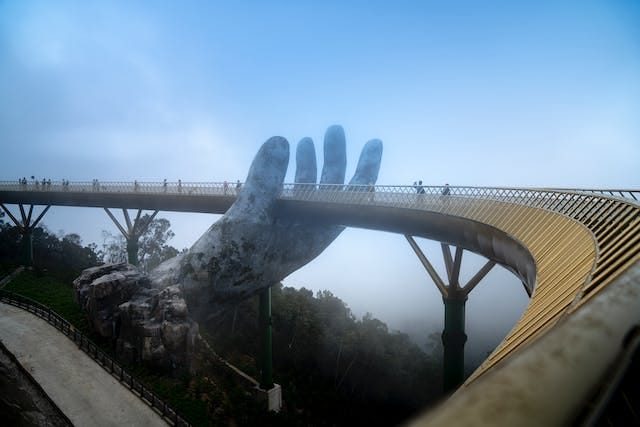
Uncharted Destinations
Embark on a journey to Vietnam's hidden gems, where the authentic charm of the country unfolds away from the tourist crowds. Explore lesser-known destinations that offer a glimpse into the heart and soul of Vietnam. From secluded villages nestled in the lush countryside to untouched natural wonders hidden in remote corners, this section serves as a guide to places untouched by mass tourism. Experience the genuine hospitality of locals, immerse yourself in the rhythm of everyday life, and discover the beauty of Vietnam's uncharted territories.
Local Culinary Adventures
Vietnam's culinary scene is a vibrant tapestry woven with flavors and traditions that go beyond the walls of popular eateries. Delve into the heart of Vietnamese cuisine by exploring street food stalls, bustling local markets, and humble family-run establishments. Taste the authentic flavors of pho simmering in fragrant broth, indulge in banh mi bursting with fresh ingredients, and sample regional specialties that reflect the country's diverse culinary heritage. From bustling cities to tranquil villages, embark on a culinary journey that tantalizes the taste buds and celebrates the rich tapestry of Vietnamese flavors.
Cultural Immersion
Immerse yourself in the cultural tapestry of Vietnam by participating in local activities, festivals, and community events. Gain insights into the country's rich heritage as you engage with locals and partake in age-old traditions. From vibrant festivals that celebrate the lunar new year to ancient rituals passed down through generations, Vietnam offers a myriad of opportunities to experience its cultural wealth. Explore traditional handicraft villages, witness mesmerizing performances of water puppetry, and embark on guided tours led by knowledgeable locals eager to share their heritage and customs.
Tranquil Retreats
Escape the hustle and bustle of Vietnam's bustling cities and tourist hotspots by seeking out serene retreats and natural havens. From pristine beaches fringed by swaying palms to hidden temples nestled amidst emerald-green mountains, Vietnam's tranquil retreats offer a sanctuary for those seeking solace and rejuvenation. Whether you're unwinding on the secluded shores of Con Dao Island, meditating in the serene surroundings of Tam Coc, or exploring the ancient ruins of My Son Sanctuary, discover the beauty of Vietnam's peaceful and less-explored corners.

Transportation Tips
Navigate Vietnam's vibrant landscapes and bustling cities with ease by embracing efficient and authentic modes of transportation. From bustling cities to remote villages, Vietnam offers a diverse range of transportation options that cater to every traveler's needs. Hop aboard a local bus to experience the rhythm of everyday life, embark on a scenic train journey through the lush countryside, or explore bustling cities on the back of a cyclo. Embrace the spirit of adventure by navigating Vietnam's transportation network like a local, discovering hidden gems and off-the-beaten-path destinations along the way.
Responsible Tourism
Embrace responsible tourism practices to preserve the authenticity and beauty of Vietnam for future generations. Respect local customs and traditions, support community-based initiatives, and tread lightly on the environment as you explore the country's diverse landscapes and cultural heritage. Engage with local communities in a meaningful way, contribute positively to the destinations you visit, and leave a lasting impact that benefits both travelers and locals alike. By practicing responsible tourism, you can help protect Vietnam's natural wonders and cultural treasures while creating meaningful and authentic travel experiences.
FAQs (Frequently Asked Questions):
Q1: How can I discover hidden gems in Vietnam?
A1: Explore lesser-known destinations, ask locals for recommendations, and consider joining community-based tours for an authentic experience.
Q2: Are there alternatives to popular tourist attractions in Vietnam?
A2: Absolutely! Seek out off-the-beaten-path destinations, explore local markets instead of crowded attractions, and consider visiting lesser-known temples and historical sites.
Q3: What is the best way to experience authentic Vietnamese cuisine?
A3: Venture beyond tourist areas and explore street food stalls, local markets, and family-run restaurants to savor authentic Vietnamese flavors.
Q4: How can I engage with the local community and culture?
A4: Participate in local activities, attend festivals, and interact with locals. Homestays and community-based tourism initiatives offer unique cultural experiences.
Q5: Are there eco-friendly and responsible tourism options in Vietnam?
A5: Yes, support eco-friendly accommodations, choose responsible tour operators, and be mindful of your environmental impact to contribute positively to Vietnam's authenticity and sustainability.
In conclusion, Vietnam offers a wealth of opportunities for travelers to avoid tourist traps and embrace an authentic journey that celebrates the country's rich heritage and natural beauty. By exploring uncharted destinations, indulging in local culinary adventures, immersing in cultural traditions, seeking out tranquil retreats, navigating transportation like a local, and practicing responsible tourism, travelers can unlock the hidden charms of Vietnam and create memories that go beyond the typical tourist experience. Whether you're exploring bustling cities, tranquil villages, or pristine natural landscapes, Vietnam invites you to embark on a transformative journey that leaves a lasting impression and fosters a deep connection with the country and its people.
China Promotes Green Workplaces & Fiscal Responsibility: Public Servants Bike & Ditch Disposable Cups
When China’s Communist Party put officials on notice that they must get used to tightening purse strings for years to come, the response was swift.
Dubai Recovers After Historic Rainfall Overwhelms City In 2024
The storm began with moderate rain on Monday but intensified dramatically on Tuesday. According to Dubai International Airport
Conquer Europe on a Budget: Insider Tips for Affordable Travel
Conquer Europe without breaking the bank with insider tips for affordable travel. Discover budget-friendly accommodations, transportation hacks, and off-the-beaten-path experiences for an unforgettable and economical European adventure
Backpacking Southeast Asia: The Ultimate Guide for Shoestring Adventurers
Embark on the ultimate adventure with our guide to backpacking Southeast Asia. Discover budget-friendly tips, hidden gems, and must-see destinations for shoestring adventurers exploring this vibrant region
- DESTINATIONS
- TRAVEL STYLES
- MOST SELECTED TOUR
- OUR PARTNER
Giỏ hàng trống
- Bạn chưa có sản phẩm nào trong giỏ hàng!

- - Sapa - Lao Cai
- - Ha Long - Quang Ninh
- - Ninh Binh
- - Nha Trang
- - Mui Ne - Phan Thiet
- - Mekong Delta

Warning About Tourist Traps in Vietnam: How to Stay Safe and Avoid Scams
When it comes to exploring a new destination, the thrill of discovery and adventure is what often drives tourists. However, amid the excitement, there are pitfalls that can turn your dream vacation into a nightmare. In this article, we want to shed light on the issue of tourist traps in Vietnam and provide valuable insights on how to stay safe and avoid scams. So, let's dive into the world of travel scams and how to protect yourself.
I. Common scams
Imagine this: You arrive in a vibrant city like Hanoi and decide to take a leisurely cyclo ride through the bustling streets. It seems like a great way to soak in the local culture. However, as you finish your short 5-minute ride, the driver demands a staggering 400,000 VND (approximately 16 USD) for the service. This is an eye-popping figure, especially when you consider that a typical taxi ride might cost you just 1 USD.
A common mistake tourists make is not agreeing on a price beforehand. Even if they do, cyclo drivers often slyly inspect your wallet and demand more. This is just one example of the many scams that tourists fall victim to, and it highlights the importance of being prepared. Tour guides can be a safeguard against such scams, but what if you prefer to explore independently?
The Gem or Art Scam: A stranger may lead you to a gemstone or art store, convincing you that it's a special opportunity to buy valuable items. Prices in such stores are often significantly inflated. To avoid falling for this scam, research the value of the items beforehand and purchase from reputable shops.
The Fake Tickets Scam: Purchasing tickets for tours or events from unreliable sources may result in receiving counterfeit tickets. Always buy tickets from trusted vendors, official counters, or directly from the event's official website, if available.
The Overpriced Food and Drinks Scam: Some restaurants or bars might intentionally charge tourists higher prices. To avoid this, check the menu and inquire about specific prices if necessary before ordering.
The Bag or Camera Snatching Scam: In crowded tourist areas, there's a risk of having your bag or camera snatched. Ensure your bag is securely fastened and keep a tight grip on your camera when not in use.
Remember, being cautious and familiar with these scams is essential to protect yourself from unexpected situations while traveling in Vietnam or anywhere else.
II. Staying Safe in Vietnam: Tips to Avoid Scams
Nothing is Free: Remember the golden rule - nothing is truly free. When street vendors or strangers offer you free rides, coconuts, or street snacks, it's essential to be cautious. Politely decline their offers and continue on your way. These seemingly generous gestures can quickly turn into costly traps.
Be Wary of Taxis and Grab Bikes: Hailing a taxi or a grab bike from the street might seem convenient, but it's a risky move. Many taxis look virtually identical, and it's easy to be lured into a tourist trap. To avoid this, rely on reputable taxi companies recommended by your hotel or use the Grab app, which allows you to track prices and drivers.
Street Vendors : In Hanoi, street vendors can be persistent and seem helpful. They may assist you in crossing the busy streets, place their wares on your shoulders, and even offer to take an "authentic Vietnamese photo." However, the catch is that they will charge you exorbitantly for these gestures of 'kindness'. Keep your distance, politely decline their 'invitations,' and move on.
The Cyclo Scam: Cyclos, the three-wheel pushing bikes, are a common mode of transport in Vietnam. Here's how the scam works: the driver quotes a seemingly reasonable price, say 150 VND, for an hour-long ride. You accept, happy with the bargain. However, when you reach your destination, it's far from your hotel, and you're surrounded by the driver's associates. They insist on a payment of 150 USD instead of Vietnamese Dong. When you protest, they can become aggressive, leaving you in a difficult situation. Unfortunately, there's often little you can do to avoid this scam.
III. VietNam Bestcare Travel - a reputable travel company in Vietnam
Exploring Vietnam is an incredible experience, but as a tourist, it's essential to be aware of the potential scams and pitfalls. While not all locals engage in these practices, it's crucial to stay vigilant and prepared. The tips mentioned above can go a long way in helping you avoid tourist traps and enjoy your time in this beautiful country.
Vietnam is a destination that offers rich culture, history, and breathtaking landscapes, and it would be a shame for your memories to be tainted by falling victim to scams. By staying informed and cautious, you can ensure that your journey is filled with positive experiences and unforgettable adventures. Remember, when in Vietnam, trust your instincts, be cautious, and don't let a few bad apples spoil your trip.
To have a safe trip, you can contact VietNam Bestcare Travel - a reputable travel company in Vietnam with reasonable prices. See more website of VietNam Bestcare Travel here: https://www.vietnambestcaretravel.com/
Các bài viết liên quan
- What is Tet? Revealing what you can do when traveling to Vietnam on Tet holiday
- Don't miss HaLong Bay Cruise when coming to Vietnam
- Snorkeling in Phu Quoc - If you haven't tried it yet, try it once
- Car rental Vietnam and things you should know
- The Quintessence Of Tonkin: Experience the Best of Northern Culture
Tên sản phẩm
Mã sản phẩm: 01923123

‘Wuxia film mogul,’ 73, tears up at 31-year-younger wife’s pregnancy check-up

Vietnam's Party approves resignation of top lawmaker

No one will buy a 100-square-meter apartment for $275,000

South Korea defeat against Indonesia due to coach's arrogance: media

Vietnam exit U23 Asian Cup following defeat to Iraq in quarterfinals

‘We will never let VinFast go’: Vingroup billionaire chairman Pham Nhat Vuong

Heroic football coach Shin extends Indonesia contract

With sea entering its rivers Mekong Delta struggles for freshwater

Heat waves to sweep across Vietnam during long weekend holiday

Van Thinh Phat chairwoman Truong My Lan appeals death sentence in $27B scam
Foreigners share how to avoid tourist traps in vietnam.

Four years ago, Indian tourist Sanja Singh was ripped off by a local vendor while walking with his friend near the Reunification Palace in downtown Ho Chi Minh City.
The vendor approached Singh and his friend and asked them if they wanted to drink coconut water. When Sanja asked how much a coconut costs, the man answered, "For free."
When Sanja asked the vendor again, he still replied "For free."
A while later, Singh and his friend insisted paying for coconut water, the vendor charged them a total of VND300,000 ($12.87), nearly 10 times against the normal price.
Sanja did not understand the exchange rate and he accepted paying such a high amount of money with a big smile, still being moved from the original offer.
After checking the exchange rate, Singh was shocked and could not understand why the vendor did it.
This was not the only time Singh had been scammed in Vietnam.
During a recent trip, Singh wanted to take photos standing beside a coconut drink push cart and he then approached a local vendor who quickly agreed with his proposal.
He thought the vendor was nice until he was asked to pay VND250,000. When he refused, the vendor chased Singh and harassed him. Finally, he paid just to stop the hassle.
Soon, he decided to share his story on social media, advising his friends "not to talk to strangers while traveling in Vietnam."
"There are nice people and then there are also people who really want to take advantage of you. As a foreigner in this country, you are really not familiar with exchange rates so if someone asks you to pay for money in thousands of dongs, you should check exchange rates to avoid being cheated," he said.
Australian Geoff Holland who used to live in Vietnam for three years also shared his experiences, warning people about the "tourist traps" one can encounter while in the country.
Holland said was often a victim of taxi scams as a driver would charge him double the meter fare.
He advised people to the install Grab app after arriving in Vietnam.
"Without Grab, people should only choose taxi services from Vinasun and Mai Linh, the most prestigious brands in Vietnam," he said. "If tourists choose to take a taxi, please remember to ask how much it will cost before getting in the car."
After one year of solo backpacking in Vietnam, an American man called Huff said the most important thing was to memorize the exchange rate between USD and VND.
"You should remember $10 is equivalent to around VND230,000 and $20 equivalent to around VND500,000, the largest denomination in Vietnamese currency system," Huff said.
"If you eat a bowl of Hue-style beef noodle soup ( bun bo Hue ), and the vendor asked you to pay $10, say no because $10 is too expensive."
Miquel Angel, founder of the MQL sustainable travel solutions company, said tourist scams have become a deep-rooted problem in Vietnam for years.
"Foreigners were scammed while in Vietnam and then they told their stories to their friends and relatives and that’s why many have not returned," he said.
Although the tourism industry has launched hotlines to receive feedback and complaints from foreign tourists, most say the hotlines do not work properly.
Vietnam opened its border on March 15 last year, becoming one of the first Southeast Asian countries to fully reopen to tourism.
However, it is lagging far behind its neighbors in post reopening tourism recovery as the country only received 3.7 million foreign tourists in 2022, around 70% off its target.
Industry insiders blame weak law enforcement and meager fines for the pervasive fraud perpetrated on visitors, including tricking foreigners into buying things at unreasonable prices.
In Vietnam, those deceiving tourists can face fines of up to VND10 million.
- Tắt chia sẻ

Avoiding Tourist Traps in Vietnam: Foreigners Share Experiences and Advice
- July 6, 2023
Welcome to Vietnam Untold. Today, we turn our attention to Vietnam, where foreign tourists share their experiences and offer advice on avoiding falling into tourist traps. Let’s take a closer look.
Many foreign tourists have taken to social media to share their experiences of being scammed while visiting Vietnam and to warn others about the potential pitfalls.
One such incident involved Sanja Singh, an Indian tourist who fell victim to a local vendor near the Reunification Palace in downtown Ho Chi Minh City.
Singh and his friend were approached by a vendor offering them coconut water. The vendor repeatedly claimed it was free when they asked about the price. However, after consuming the coconut water, they were charged a staggering $12.75, almost ten times the average price. Unaware of the exchange rate, Singh paid without realizing the scam’s extent.
This wasn’t an isolated incident for Singh. On a recent trip, he approached a vendor for a photo opportunity next to a coconut drink push cart. The vendor quickly agreed but demanded $10.63 for the privilege. When Singh refused, the vendor became aggressive, forcing him to pay to avoid further confrontation.
Singh took to social media to share his story, advising fellow travelers to be cautious when dealing with strangers and continuously checking exchange rates to avoid cheating.
Similarly, Australian traveler Geoff Holland, who lived in Vietnam for three years, warned about taxi scams where drivers would charge double the meter fare. Holland recommended using the Grab app or choosing taxis from reputable companies like Vinasun and Mai Linh.
Another seasoned traveler, an American named Huff, emphasized memorizing the exchange rate between USD and VND. He advised tourists to be cautious when faced with inflated prices, noting that $10 should only equate to around VND230,000 and $20 to approximately VND500,000.
Miquel Angel, the founder of the MQL sustainable travel solutions company, acknowledged that tourist scams had been a longstanding issue in Vietnam, leading to many negative experiences shared among friends and relatives. Despite the tourism industry’s efforts to establish hotlines for feedback and complaints, foreigners have expressed dissatisfaction with their effectiveness.
Vietnam, which reopened its borders is striving to recover its tourism industry. However, it has fallen behind its neighboring countries, with only 3.7 million foreign tourists visiting in 2022, a significant shortfall from its target. Industry insiders attribute this to weak law enforcement and inadequate penalties for fraudulent practices, including selling items at exorbitant prices.
In Vietnam, individuals found deceiving tourists can face fines of up to $425. However, critics argue that stricter enforcement is needed to combat the deep-rooted problem of scams.
Thanks for watching Vietnam Untold, and Stay tuned for more news.
Be the first to uncover the untold stories about Vietnam & Vietnamese Americans – Power, Business, Culture and Food.
- Visa Status
- Dashboard My Profile Log Out
Your has been successfully Logout.
Insider Tips from Travelers Avoiding Tourist Traps in Vietnam
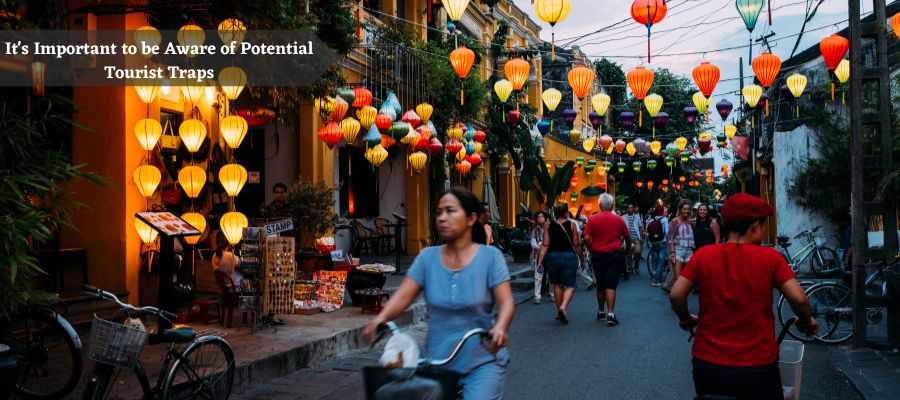
Vietnam offers a captivating blend of natural beauty, rich history, and vibrant culture that attracts millions of tourists each year. While exploring this Southeast Asian gem, it's important to be aware of potential tourist traps and scams that can dampen your travel experience. In this comprehensive guide, we present insider tips from seasoned travelers who have shared their cautionary tales and valuable advice to help you navigate Vietnam's tourist landscape with confidence. By following these recommendations, you can make the most of your journey while avoiding common pitfalls.
Beware of Overpriced Coconut Water
One common scam that unsuspecting tourists encounter is the overpricing of coconut water. Sanja Singh, an Indian traveler, fell victim to this scam near the Reunification Palace in Ho Chi Minh City . A vendor approached Singh and his friend, offering them coconut water for free. However, when they insisted on paying, the vendor charged them a staggering VND300,000 ($12.87), nearly ten times the normal price. To avoid falling prey to such scams, it's crucial to inquire about the cost upfront and compare it to prevailing market rates. Familiarize yourself with the approximate prices of common items and be wary of unusually high charges.
Taxi Scams and the Grab App
Taxi scams are a common concern for travelers in Vietnam. Geoff Holland, an Australian who lived in the country for three years, often encountered drivers who demanded fares significantly higher than the metered amount. To mitigate this risk, Holland recommends using the Grab app, a popular ride-hailing service available in Vietnam. The Grab app ensures transparent pricing and offers a safe and reliable means of transportation. Alternatively, if you choose to take a taxi, opt for reputable companies like Vinasun and Mai Linh, known for their fair pricing and reputable services. Always confirm the estimated cost before entering the taxi to avoid surprises.
Familiarize Yourself with Exchange Rates
Understanding the exchange rate between your home currency and the Vietnamese dong (VND) is essential for avoiding scams and unfair pricing. Huff, an American traveler who spent a year backpacking in Vietnam, emphasizes the importance of memorizing the exchange rate to protect yourself from overcharging. For example, knowing that $10 is equivalent to around VND230,000 and $20 is equivalent to around VND500,000 can help you assess whether a price is reasonable. This knowledge becomes particularly valuable when dining at local establishments, as some vendors may try to inflate prices for unsuspecting tourists.
Share Your Experiences and Stay Informed
Tourist scams have persisted in Vietnam for years, tarnishing the travel experiences of many visitors. Miquel Angel, founder of MQL sustainable travel solutions company, highlights the impact of sharing experiences with friends and relatives. By recounting your encounters with scams and spreading awareness, you can help fellow travelers avoid similar traps and contribute to a more transparent and accountable tourism industry in Vietnam. Stay informed about common scams by reading travel forums, blogs, and up-to-date travel guides , and be proactive in sharing your knowledge with others.
Limited Effectiveness of Hotlines
While the tourism industry in Vietnam has established hotlines to receive feedback and complaints from foreign tourists, reports suggest that these hotlines may not always be effective. Weak law enforcement and low fines for scammers contribute to the persistence of fraudulent activities targeting tourists. As a result, it's crucial to remain vigilant and rely on your own knowledge and the experiences of fellow travelers to navigate potential tourist traps effectively. Engage with local communities and seek recommendations from trusted sources to ensure a safer and more enjoyable experience.
By heeding the insider tips from experienced travelers, you can protect yourself from falling victim to tourist traps in Vietnam. Be c autious, inquire about prices in advance, compare rates, and stay informed about common scams . Utilize ride-hailing services like Grab or choose reputable taxi companies to ensure fair pricing. Familiarize yourself with the exchange rate to prevent overcharging, and actively share your experiences to help fellow travelers. With these precautions in mind, you can embark on a memorable journey through Vietnam, savoring its unique culture, breathtaking landscapes, and warm hospitality while avoiding potential pitfalls along the way.
Related Posts
Istanbul Airport Requires Visas for Transit Passengers from some Countries
Fascinating Facts to Know Before Your Visit to Sierra Leone
Fun facts about Sao Tome and Principe
Ireland: Updates for Travelers from Dominica, Honduras, & Vanuatu
Hyatt Hotels now offer personalized virtual workouts for guests
Carnival Corporation establishes a fresh Solar Park in the Dominican Republic.
The Philippines boosts tourism relationships with Austria.
Malawi Lifts Visa Restrictions for Travelers from 79 Countries
Long Queues and Scams in the New EU Entry System.
The World's Best Digital Nomad Visa Unveiled in European Country
Turkey Transit Visa for Yemeni Citizens
Turkey Transit Visa for Mauritanian Citizens
Turkey Transit Visa for Nepalese Citizens
Turkey Transit Visa for Guinea
Turkey Transit Visa for Burkina Faso
Turkey Transit Visa for Somalian Citizens
Turkey Transit Visa for Afghanistan
Istanbul Airport Sets Visa Requirements for Transit Visitors from 10 Nations
Turkey Implements Visa Requirements for Tajikistan Citizens
Greece introduces fast-track visa for Turkish tourists to 10 islands
Top Airlines Globally for Flying Families
Turkish Airlines Denies Boarding to Russia? Fly to South America Explained!
6 Months Visa-Free in Turkey for Kyrgyz! Everything You Need to Know
Turkey has implemented a tourist fee specifically for visitors to Hagia Sophia
Approximately 50,000 Turkish citizens are anticipated to seek German citizenship subsequent to the approval of a new law
Lithuania Halts Residency Applications from March
Locating Medical Support for American Travellers in Turkey: A Guide
Walk Where Gods Once Trod: A Journey Through Hierapolis
Istanbul Airport Emerged as Europe's Leading Aviation Hub in 2023
Turkey Drops Visa Requirements for U.S. Travelers
Turkey Visas for Tourism, Business Purposes
Apply for Turkish Student Visa
Turkey Work Visa or Work Permit
Turkey Transit Visa
Turkey Residence Permit
Turkey Visa Application Process
Turkey e Visa Eligible Countries
Turkey e Visa Application
Turkey Visa Online
Turkey Visa Requirements
Turkey Photo Requirements
Turkey Documents Required
Turkey Visa Fees
Turkey Visa for US
Visa Requirements for Turkish Citizens
Need Urgent Turkey Visa?
Turkish Visa
US Visa for Turkey
E Visa of Turkey
Passport for Turkey
Visa for Turkey US Citizen
Turkey Visa for Pakistani
Turkey Visa for Indian
Electronic Visa Turkey
Turkish Visit Visa
Turkey Travel Visa
Visa Application Form Turkey
Visa on Arrival Turkey
E Visa Turkey Cost
US Citizen Travel to Turkey
Tourist Visa to Turkey
Chinese Embassy Turkey
Visa Application to Turkey
Visa for Turkey From Canada
Apply Visa to Turkey
Visa Required for Turkey
Traveling to Turkey From Canada
Visa Transit Turkey
Getting a Visa for Turkey
Turkey Transit Visa for US Citizens
Visa Cost Turkey
Kenya E Visa
eVisa Kenya Online
Kenya Online Visa
Kenya e-Visa
Kenya Entry Requirements
Kenya Visa Requirements for US Citizens
Kenya Visa for US Citizens
Vaccines For Kenya
Yellow Fever Vaccine Kenya
Yellow Fever Certificate Kenya
Vaccinations Required For Kenya
Kenya Transit Visa
Kenya Multiple Entry Visa
Kenya Business Visa
Kenya E Visa Fees
Kenya eVisa Cost
Kenya evisa Application
Kenya Online Visa Application
kenya evisa Processing Time
Kenya Visa on Arrival
Sign In or Create an Account to continue
Forgot Password?
No account? Create one!
Back to Login
Already have an Account? Sign in .
Your account has been created successfully.
Your login credentials has been sent to your email id. Please find them in your inbox or spam folder.
Click here to Signin.
Vietnam - The Scams and Tourist Traps in Vietnam
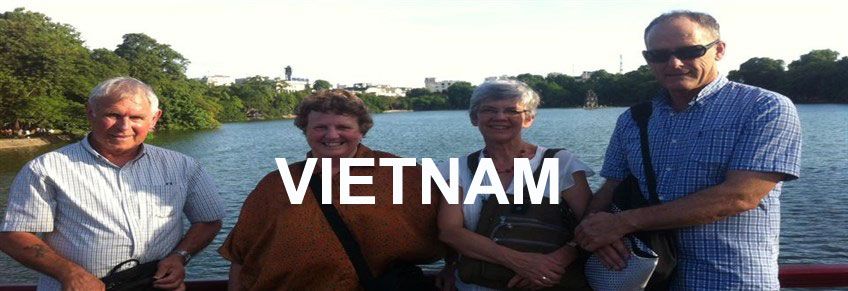
Vietnam is a beautiful country that is safe for tourists, but like any other country, it has its share of scammers, who target innocent tourists. Visiting any country for the first time definitely comes with a learning experience, be it good or bad. Not knowing the local customs and language makes you susceptible to unscrupulous individuals who might take advantage of your situation.
Some of these frauds are old and quite obvious and can avoid by being aware of your surroundings while some others are hard to detect. The best way is to stay away from fraudsters while visiting Vietnam, and be sensible about what is happening around and keeping an eye on suspicious situations.
We have compiled some of the most common scams and fraudulent activities in Vietnam right from booking your tickets to Vietnam and return to your hometown.
Fake tour operators When a travel agency gets popular, bogus companies open businesses with the same name by impersonating to keep the name and identity something similar to a reputed company. The look-alike name, logo, etc., will trick travelers who are visiting Vietnam for the first time. It is recommended to do your research online to ensurethat you are engaging with real company with bonafide credentials.
Ticket booking frauds Beware of any operators who waits at the busstation or railwaystationto target tourists. Such people claim to offer bus or traintickets for you. Do not fall for this scam as you might end up getting train tickets of low class as opposed to theirclaims of offeringsoft-sleeper class berth. Train tickets in Vietnam don’t have the class name printed on it. Hence, it is better to book your tickets yourself and politely refuse if anyone approaches offering their services.
Creating emergency Plots This one is quite popular and happens in almost all countries. Many people would get seduced into this trap when these unscrupulous people form an emergency situation where you would be urged to help them. While you leave your bags and personal belongings in the place where you are sitting (if it is a restaurant or any other site), others who are part of the gang might steal your things and flee. To avoid this kind of situation, never leave your luggage or phone isolated while moving from your place.
Overcharging by hotels There are hotels, which gives you doubled up rates upon checkoutby telling that the price quoted was per head instead of per night. To avoid this, make sure that you choose reputed hotels offering excellent customer service. Ifyou are booking a touring program via any reputed travel operator in Vietnam , you can assure the reputation of the hotel by various means, and that is the mostpreferred way to book hotels. If you have shortlisted some hotels already, make sure to confirm the address withyour taxi driverinstead of justtelling the name. There would be many small hotels in the same name hoping to stealthe business of famous hotels.
Confusion regarding currency Due to the large denomination numbers, in many countries service providers or vendors won't tell or use the full denomination value, instead, they will say in short figures, such as 5 for 50 or 500. It has become a customary practice because of the large currency denomination. Some tourist places might quote the price in USD instead of Vietnam Dong, so that overpricing is easy. Therefore, when a vendor tells you the rate is 5, make it clear whether he is talking about US$ 5 or VND 5,000. Also, make sure whether the price is for a group or an individual when visiting any tourist spots.
Massage scam There are plenty of spa and wellness centers in several cities in Vietnam including Hanoi offering massage services. Some massage centers advertise a low price for services but once you becomes their customer and when it is time to pay, they will charge for a ton of ridiculous things such as music, towels or water, etc. Another common fraud actions are targeting amorous men. Beautiful women might approach men and convinces him to come for a massage. Once the person makes the payment, the gorgeous woman will disappear, and somebody else would come in. To avoid this, check for reputable parlous by asking your tour organizer or research online and talk about the price beforehand.
Snatching and theft Like in any other country, bag snatching and thefts do occur in Vietnam too. But with a bit of caution and alertness, you can easily overcome such embarrassing situations. First of all, never flaunt expensive jewelry or accessories while going out. It would be better to leave your valuables at thehotel in private lockers. In case of any situations where you face bag snatches, it is better to abandon your bag if no valuables are inside to ensure your safety.
Tips to deal with frauds and traps Some tourist frauds and traps are apparent-like anything that is advertised on billboards asking you to be aware. However, others are a little more subtle. Here are some tips on how to avoid falling for common tourist traps in Vietnam.
• Before booking a tour package through any travel operator or booking hotels, look for star rating and user reviews to be sure of their credibility.
• Before entering a taxi, check for the driver’s license to make sure that he is professional and offers metered services.
• While booking a motorbike tour, even though it is a great idea, before tempted by the idea, talk to your hotel reception to schedule a visit with a licensed travel operator.
• If you are traveling in an overnight train or arrived at the airport, keep an eye on your bags and never get the help of luggage handler to avoid theft or get pressurizedto pay high tips.
• You may find many local vendors who might try to sell you a photo shoot with them or offering a helping hand in taking your photo. Avoid this as they might charge you after taking the picture.
• Don't draw attention by wearing expensive jewelry or clothes. Do avoid wearing heavy jewelry when you are out for sightseeing. Make sure that you don’t carry expensive accessories and jewelry if you are on a casual trip.
• Lock up your luggage and other valuable things including money in your hotel room while you leave the room for an outing.
• During shopping, always inspect goods especially electronics after buying. Switching items for cheaper version once you have purchased is a common trap you might find in Vietnam.
• Do keep the emergency number of the hotel you stay, tour operator, police, fire,and ambulance in case of any unexpected situations.
Vietnam is generally a safe country with a low crime rate, but it is good to be alert whenever traveling around Vietnam. However, never have a feeling that everyone would be trying to scam you. While these tips and tricks are for you to be aware of the situations, this should never spoil the fun and enjoyment of your trip. Becoming too cynical might spoil your trip. Be mindful of these things while visiting this picturesque country.
Vietnam Travel Guide
- Overview of Vietnam
- Vietnamese History
- Vietnamese People
- Vietnamese Costume
- Vietnamese Religion
- Vietnamese Lifestyle
- World Heritages in Vietnam
- Beautiful Vietnam Beaches
- Vietnamese Festivals and Events
- Vietnamese Food and Drink
- Vietnamese Music and Instrument
- Shopping in Vietnam
- Things to do in Vietnam
- Best time to visit Vietnam
- Visa to Vietnam
- The Scams and Tourist Traps in Vietnam

Our journey through Vietnam – wonderful places and tourist traps
As I was saying in my other articles, Vietnam is so contrasting and diverse that it was hard for us to say if we love it or hate it, and there’s no middle way!
The same applies to the places you can visit in Vietnam . There are lots of famous locations, countless photographs and hundreds of articles on the Internet; but still, it is difficult to understand anything before seeing with your own eyes.
We spent 18 days in Vietnam with our son. We established a base for each area we planned to cover and visited the surroundings from there, as follows:
- Hanoi (3 days)
- Tam Coc (3 days)
- Hoi An (5 days)
- Ho Chi Minh City (4 days)
- Can Tho (3 days)
We were flying between the main regions (Hanoi-Da Nang-Ho Chi Minh), took the train from Hanoi to Ninh Binh and traveled by car between HCMC and Can Tho. For what we visited we either took an organised tour or traveled short distances on a motorbike.
See below what we loved from what we’ve seen in Vietnam and where our expectations were much higher than the reality.
Hanoi was our first encounter with Vietnam, and it was quite a shocking one. We were coming from Chiang Mai , which we loved for its relaxed atmosphere and beautiful nature. So the crowded and polluted Hanoi was very different!
I can understand why Hanoi is such a popular destination for young travellers. It has a distinct vibe and amazing nightlife. The streets seem to be crowded and packed with people 24 hours a day. It is also very budget-friendly, especially if you can make a bit of a compromise from a food hygiene perspective.
But for me, Hanoi is one of the few places we’ve been that I don’t consider enjoyable to travel with kids.
Check here for you accommodation in Hanoi.
Ninh Binh region was our favourite place in Vietnam. No wonder why the surreal karst landscape earned its nickname “Inland Ha Long”. But, unlike its more famous counterpart, you won’t find the same crowds in Ninh Binh. We enjoyed to explore Ninh Binh by ourselves, at our own peace. It is best to be experienced on two wheels, bike or scooter, depending on your personal preferences. The area is getting popular, but still remains authentic, not at all over-touristic.
We stayed in Tam Coc for 3 nights, so we had 2 full days to explore the surroundings. I would say this is perfect to get a taste of the area. We loved Trang An and the views from Hang Mua, even though January is not the perfect time to explore Ninh Binh. It was quite cloudy and foggy, drizzling at times.
You can find here the best choices to stay in Tam Coc.
If you visit Ninh Binh with kids, don’t miss Chookie’s Beer Garden for a tasty meal or a relaxing drink. For us it was the perfect place to take a break from local food, as Eric was missing the meals back home. They even have heaters on the terrace, perfect for Northern Vietnam winters, plus a playground, which you don’t see often over here.
Ha Long Bay
The iconic image of Vietnam, we could not miss seeing the unique islands from Ha Long Bay. Unfortunately, we felt this is a huge tourist trap. Don’t get me wrong, the landscape is amazing, truly worth seeing, but the crowds and poorly organised tours can ruin your whole experience. Plus that the travel brochures don’t really set the right expectations: I doubt the waters in Ha Long Bay are ever that blue!
Since we were in Hanoi with a toddler, we were reluctant to go to Ha Long Bay for a few days. We’ve been with him on a boat before, even for more than one week, so this wasn’t an issue. But here I wasn’t sure about the facilities, food etc. on the boat and reluctant to be trapped on a place I wasn’t sure we would enjoy. Plus the January weather is not the best in Northern Vietnam!
Instead, we chose a day trip from Hanoi. Not a very smart idea, as we were on the road for about 7 hours (including two unpleasant 30 minutes stops on the way at some souvenir shops), just to be on the actual tour for less than 3 hours. Doing such a short trip did not allow us to see enough of the bay and islands and we basically spend the time in the most crowded areas.
I would advise you to visit Ha Long Bay, but only if you can allocate minimum 3 days/2 nights to this activity. You can find good accommodation options here . Otherwise, I don’t think it is worth the time and money and it is better to skip it altogether!
Even if we were flying to/from Da Nang, we chose to spend all our time in Central Vietnam in Hoi An. This was a great idea! The little town, listed as UNESCO heritage site as well preserved Southeast Asian old trading port, is an oasis of calm and relaxation. It is totally different than the large Vietnamese cities. Hoi An is made of tiny streets, with old architecture, lit in the night by colourful paper lanterns. There are lots of tiny terraces and bistros where you can try delicious Vietnamese dishes or fresh seafood. Eric loved the evening walks by the river and the wooden fishing boats.
Check here for the best accommodation options in Hoi An.
Not very far from Hoi An, there is My Son temple, another UNSECO site. This used to be an important center of the Champa civilisation, starting from the IVth century. Unfortunately, a significant part was destroyed during the Vietnamese War, bombed by the Americans. But what remained untouched is impressive, well preserved due to latest efforts, a must-see in Central Vietnam.
If you are in Hoi An with kids, I recommend you to have breakfast or lunch at Dingo Deli. Actually you might spend there a while! This is a nice bistro, with sandwiches, awesome desserts and great coffee. But you will not be here for the food, the playground is the big star! Dingo Deli features both an indoor and an outdoor space for kids Eric was thrilled about. He enjoyed his time here so much that even pasta with tomato sauce could hardly convince him to take a break from playing (and he loves that too!). Each time we stopped by Dingo Deli we met families with kids from all around the world; it was lovely to see the little ones playing together, with no language barriers.
Ba Na Hills
The image of the “hands bridge” close to Da Nang is all around the internet and social media. It appears as an iconic place, a must-visit in Central Vietnam. It is indeed an interesting idea and the way up there is truly magnificent. The cable car holds several Guinness World Records and the ride up to the clouds, above the rainforest and waterfalls was one of the best we ever had. Still, the bridge itself is not as impressive as seen on Instagram. It has an interesting architecture but it is basically going nowhere. Extremely crowded, you can hardly take a picture of yourself or enjoy the views without compromising other people’s photos. This if you are lucky enough to see anything. The panorama from up there is amazing, but is covered in fog and clouds most of the time.
From the Golden Bridge you can take another cable car to go to the French Village, which we found quite kitsch. Seeing European architecture in real life and size we can’t find really appealing a small, pale copy of it… but maybe we are biased on this.
When you visit Ba Na Hills, make sure you take at least a light jacket with you, the weather up there is unpredictable and much colder than on the coast.
Ho Chi Minh City
Ho Chi Minh is a crazy, chaotic city. It is one of the busiest and crowded cities we’ve ever experienced. You get tired very quickly over there!
You can find here the best hotel options.
But you must visit Ho Chi Minh City when you are in Vietnam, to see the War Remnants Museum! We spent a whole morning there, but could stay for much longer. Prepare yourself for a heartbreaking experience, that will leave a strong impact on yourself. No matter what you heard or read about the Vietnam War before, you can’t be fully prepared for what you see here! Luckily, inside the War Remnant Museum there is a small playroom room for kids, where I took a break at some point to stay with Eric. Playing together cheered me up up and I got back my positive mood.
In Ho Chi Minh we also recommend Ben Thanh Market, the best street food market we’ve experienced in Vietnam. It has a great atmosphere, with live music in the evening and the food is awesome, with various Vietnamese, Thai or Indian specialties.
Mekong Delta
Mekong delta was one of the first things on my list when planning for Vietnam. Maybe I set wrong expectations, but it didn’t impressed me as much as I would have expected. Or maybe you need to go deeper into Mekong for a more natural feeling.
Check here for your accommodation in Can Tho.
We chose to stay in Can Tho, 2.5 hours away from Ho Chi Minh City as this is supposedly the most authentic side of Mekong delta. Anything closer to Ho Chi Minh City is mostly crowded and touristic. Can Tho is the largest floating market in Vietnam and one of the few that still functions as a real market for the locals. You can see here people trading agricultural products from all around the region. Sellers stay on the boat for days and even weeks and some even have their family and young kids over there. We were floating around to see large boats, wholesale only, but also smaller ones approaching us to sell fruits or drinks.
Apart from the floating market we visited a farm where we had a chance to see various tropical trees and taste their fruits. We’ve already seen most of them before, in Sri Lanka , but it would be an interesting walk for a first-timer. They also had a pond with pangas fish and now I understand better the advice from various nutritionist to avoid eating this type of fish. At the end of the tour, we passed through a rice-noodles factory which was quite interesting, even though I doubt it is “the only one” in Can Tho, as indicated by our guide.
Hi Author! Glad to see such a great post, reflecting the ability of a good content writer. Thanks for sharing this with us, I hope you will post more great blog like this.
[…] Vietnam, where we travelled north to south, with 5 major stops in Hanoi, Ninh Binh, Hoi An, No Chi Minh and Can Tho […]
[…] to Get There: The best option to visit My Son Sanctuary is by renting a scooter. It’s a one-hour ride from Hoi An through a picturesque, authentic rural […]
[…] means in terms of crowds! We’ve learned our lesson about day trips in very touristic locations in Vietnam’s Ha Long Bay and promised not to make the same mistake again. So we decided to spend a few nights on Phi Phi […]
[…] traveling to Vietnam, it is very likely that you will need a visa to enter the country. But Vietnam visa is more a […]
[…] Our trip to Vietnam gave us very weird, mixed feelings. We enjoyed some aspects but totally hated others, so I can’t truly say weather we liked it or not. Friends usually ask me for recommendations from the places we’ve been, but after our trip to Vietnam I’m not able to decide to advise people go there or not. And it’s not just me! Official reports say that most of Vietnam visitors never go back; only about 30% of them pay a second visit, which is much lower than in other countries in South-East Asia. […]
Share your thoughts Cancel reply
Your email address will not be published. Required fields are marked *
Save my name, email, and website in this browser for the next time I comment.
the.happykid
Creștem și Călătorim , Momadica , On My Way , Părinți Călători , Piciorușe Călătoare , Travelista
- Elara Pro by LyraThemes.com
- by The Happy Kid

How to Avoid Tourist Traps on Your Travels
A guide on how to truly immerse yourself in a new place..
- Copy Link copied

Tourist traps are everywhere tourists can be found, and they can ensnare us all. But what exactly is a tourist trap?
Illustration by Melanie Lambrick
Like many of you, I’ve been caught in the occasional “tourist trap” over the years. I’ve found myself waking up in a cookie-cutter hotel room, with a generic print of a local landmark over the bed, or on a street full of gift shops selling puntastic T-shirts. Then I ask myself, “How did I get here? Aren’t I a better traveler than this?”
Tourist traps are everywhere tourists can be found, and they can ensnare us all. But what exactly is a tourist trap? And how should we think about them?
What constitutes a tourist trap?
A tourist trap is, by definition, a place that attracts and exploits tourists. But Merriam-Webster doesn’t leave much room for nuance. After all, one person’s trap is another person’s treasure.
A tourist trap is often cast as the opposite of an “authentic” experience. It’s somewhere we skip if we’re looking for the “soul” of a destination. But what makes, say, visiting a hidden supper club in Hackney more true to London than watching the Changing of the Guard at Buckingham Palace? Who’s to say what is truly “authentic,” anyway?
There’s also a distinction between a tourist hot spot and a tourist trap. Many hot spots—for example, the Eiffel Tower—are marvels of engineering, nature, or culture that are kept standing, alive, or protected for visitors. The trinket stalls that surround them, however, err on the side of traps.
Instead of asking how to avoid tourist traps, perhaps a better question is: How can travelers more deeply immerse themselves in a new city—to experience both its beloved landmarks and the places less familiar to the average visitor?
Seek out local experts
“Avoiding ‘inauthentic’ experiences requires research and advance planning,” says Lindsey Tramuta , a Paris-based writer who offers small group tours of the city. “However, it can be as simple as scoping out who the local, trustworthy voices are.”
She recommends reading the work of writers who live in the city you’re visiting, as well as following chefs or restaurant owners on social media.
Tune in to the local frequencies
Mary Rickard, a semi-retired journalist who leads walking tours of New Orleans through Context Travel , suggests tuning in to the local radio station and reading the newspapers to get primed before your trip. You’ll also find out about concerts, art exhibitions, and other community events.
In New Orleans, for example, musicians are often guests on WWOZ radio shows leading up to performances. Attend a gig and you might strike up a conversation that teaches you something new about the city and the people who live there.
Step away from the tour bus
Coach tours can play a valuable role in facilitating travel if you’re unable or unwilling to make your own way in unfamiliar territory. But renting a car, Rickard says, can offer “a more leisurely experience of less-visited sites and roadside restaurants.”
The same is true for other, more independent, forms of transportation—like walking, cycling, and taking public transit. If I’d done that in Marrakech a few years back, I’d have spent less time in my taxi driver’s cousin’s perfume shop.
Seek out new neighborhoods
A city’s heart may be found among its lesser known arteries. Joan Roca, CEO and founder of Essentialist , a private members’ service for travelers, recommends doing a little research in advance—but also, when you feel safe to do so, letting yourself go with the flow in the present.
“Take that map out, and make note of where the big attractions are and what is familiar to you,” he says. “Then look to the other spaces on the map. Perhaps it’s a green space . . . perhaps it’s a maze of streets away from the well-known areas that’s caught your eye.”
Consider when you travel
Meaningful interactions can be had at quieter times of day and year, as a dawn visit to St. Peter’s Basilica in Vatican City with an infant once taught me. “Traveling in the low season,” Roca says, “will help avoid both tourists and traps alike.”

Vietnam Tourist Traps – How To Avoid Them For An Amazing Trip
Foreign travelers always find Vietnam in general, and Saigon, Hoi An, Ha Noi… in particular, to be fascinating and alluring travel locations. Many people’s first thoughts when considering these locations are ones of friendliness and kindness.
Vietnam is a stunning nation that is safe for travelers, but like any other nation, it has its fair number of con artists that prey on unwary tourists. Any first-time visit to a place is bound to teach you something, whether it’s good or unpleasant. You are more vulnerable to dishonest people who might take advantage of your circumstances if you are unfamiliar with the regional norms and language. What does “tourist trap” actually mean?
1. What do tourist traps in Vietnam look like?
“Tourism traps” are con games played by business households and locals on international tourists visiting Vietnam. In actuality, your money—not you—is their main objective!
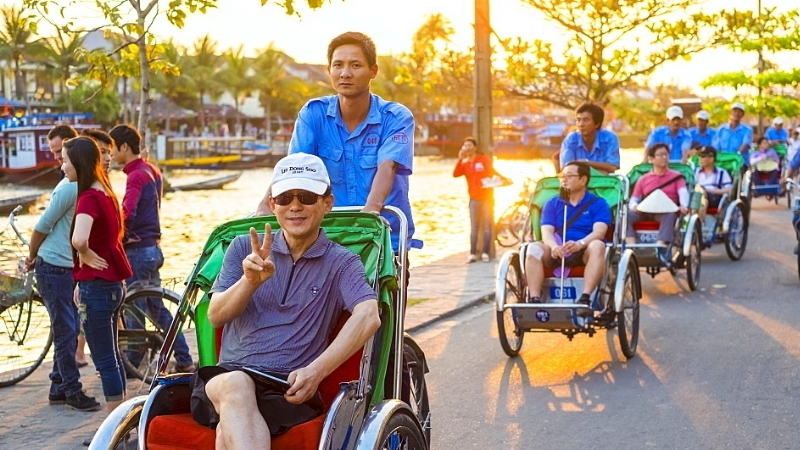
There are now some widespread scams in Vietnam’s tourist areas, including those using phony taxis, traditional motorcycles, street vendors, and the sale of items at exorbitant costs. Most tourist traps and frauds take place in well-known tourist destinations or locations like Bui Vien Street, Independence Palace, Cathedral of Notre Dame, Ben Thanh Market, Hoi An, or Hanoi Old Quarter.
International tourists are just “bewildered golden deers” always in the sights of “the hunters” when they visit these places. “So why, in local tourist areas, are tourist traps and frauds so uncommon? ” – Some visitors have asked.
2. Why do you often get trapped at the tourist attractions more than local places?
The most plausible cause is possibly the reputation of these places. Millions of results identical to the places I mentioned can be found in a matter of seconds when you search on Google for the term “Saigon/Hanoi top tourist destinations.” As a result, tourist traps are common there. Crowds are frequently used by con artists to accomplish their ruses in greater secrecy and target more international tourists.
For the time being, I’ll keep talking about tourist traps. How might tourist traps in Vietnam be avoided? And what must you know before visiting Vietnam? I’ll respond truthfully, as if I were on my own Vietnam tour. So let’s get on the way!
3. How to avoid tourist traps when traveling in Vietnam?
3.1. fake taxis.
On their family tours of Vietnam, tourists may run into illegal taxi drivers who employ a variety of techniques to con their foreign passengers. Using the customized meter, which will operate much more quickly than usual and result in higher than anticipated rates, is a popular practice. Additionally, they will take the longer routes in order to up the prices even more.
The typical “fake taxi” scam involves running the meter “without 000.” For instance, you would be required to pay 500.000 VND even though the actual cost is only 50.000 VND. Fortunately, “fake cabs” are currently prohibited at the airport thanks to some official rules from the government. They still mostly show up at tourist attractions, though.
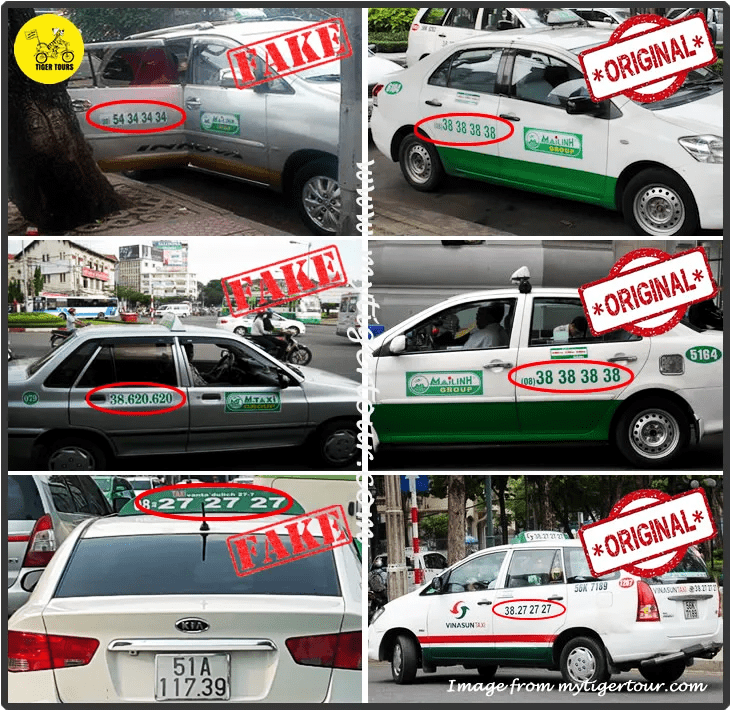
Showing that you know where you’re going even though you don’t is a traveler’s trick. You’ll be taken in if you appear to be lost or to be studying a map.
Utilizing a reputable brand, like Vinasun or Mai Linh, will help you avoid the majority of taxi frauds. These cabs should be easily identifiable thanks to their logos and colors.
- Vinasun hotline: Vinasun Taxi
- Mai Linh hotline: Mai Linh Taxi
Additionally, for added security, you can reserve a cab using an app. My two suggestions for reserving a taxi in Vietnam are Grab and Be.
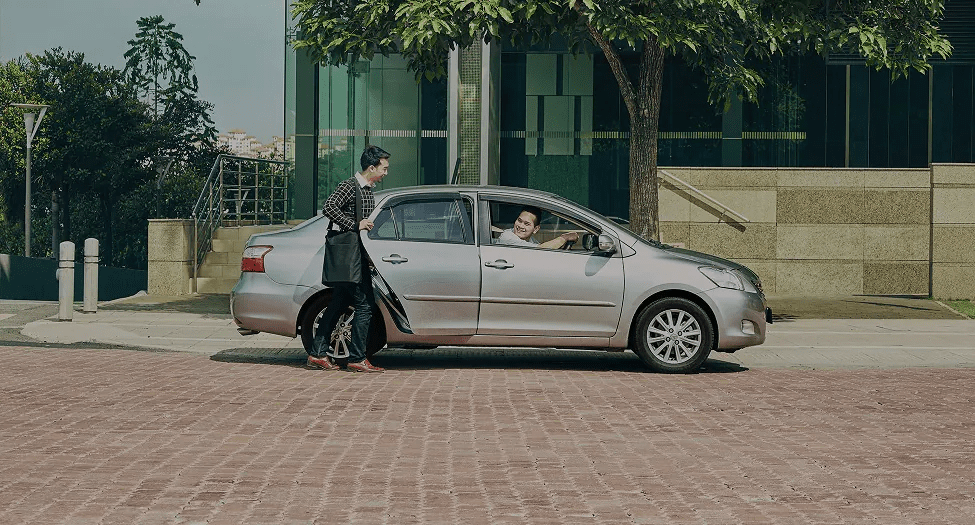
3.2. Motorbike taxis
The Xe Om (motorcycle taxi), a common mode of local transportation, is used by tourists. When speaking specifically of conventional motorbike taxis, overwhelming calls from them may make you fearful and fixated.
Motorbike taxi drivers will approach visitors in tourist places and draw them in with their catalogs’ plethora of intriguing photographs. Additionally, they charge a very low cost for their motorbike-taxi tour, but do not rejoice too fast. because the tourist traps they utilize are merely easy techniques.
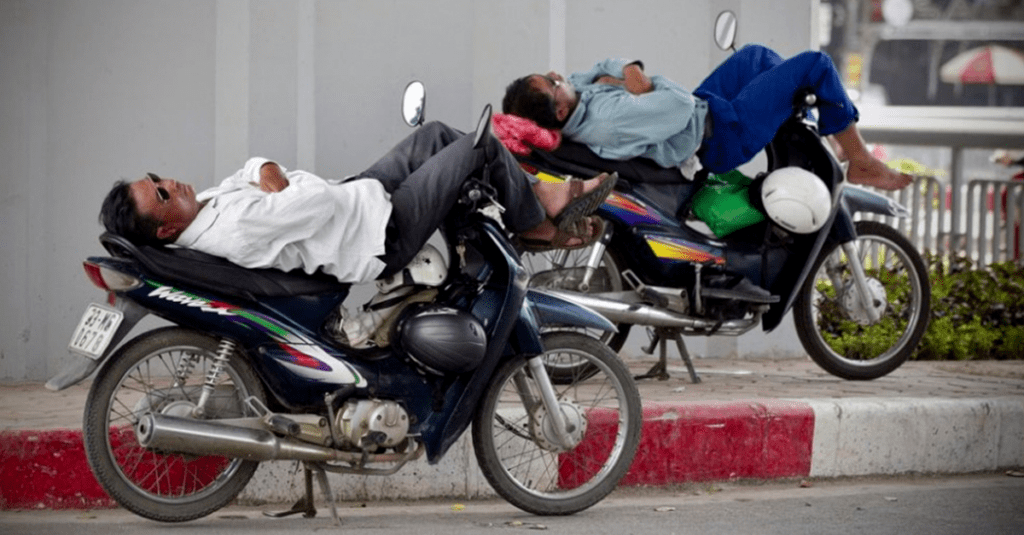
In other words, they agree to the price of the trip you discussed up front and then demand extra money when you get there. They claim that you must not have heard them correctly.
Similar to taxis, you can book a motorbike taxi through certain well-known applications including Grab, Be, and Go Viet. In reality, Vietnamese users frequently use these programs, particularly Grab. I believe that doing this will help you avoid the tourist trap offered by conventional motorbike taxis.
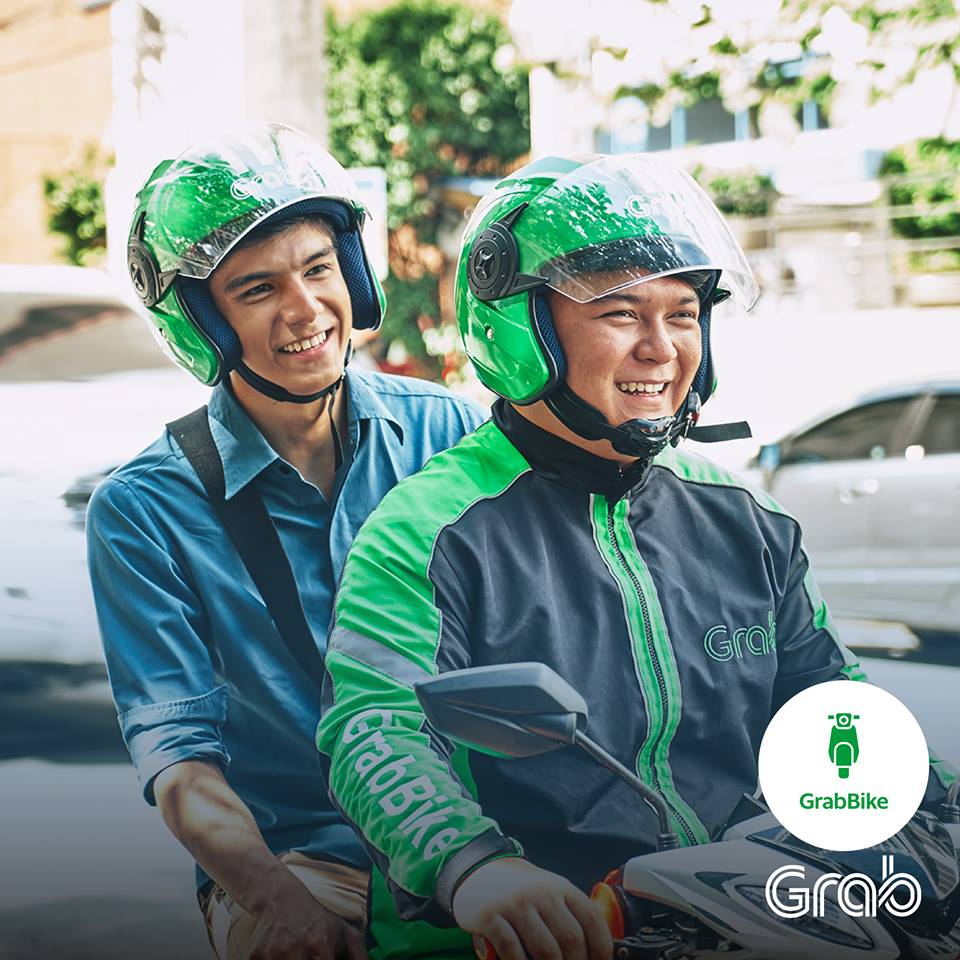
3.3. Cyclo tour
Similar to taxi scams in frequency, cyclo scams can occasionally even be more deadly. Everywhere in Ho Chi Minh City, but particularly in District 1, you can find cyclos or bike taxis advertising for business on nearly every corner, and some of them are skilled at charming unwary tourists into joining them for a trip. However, be careful that compared to cyclos you hire via a hotel, these independent ones are more likely to con you.
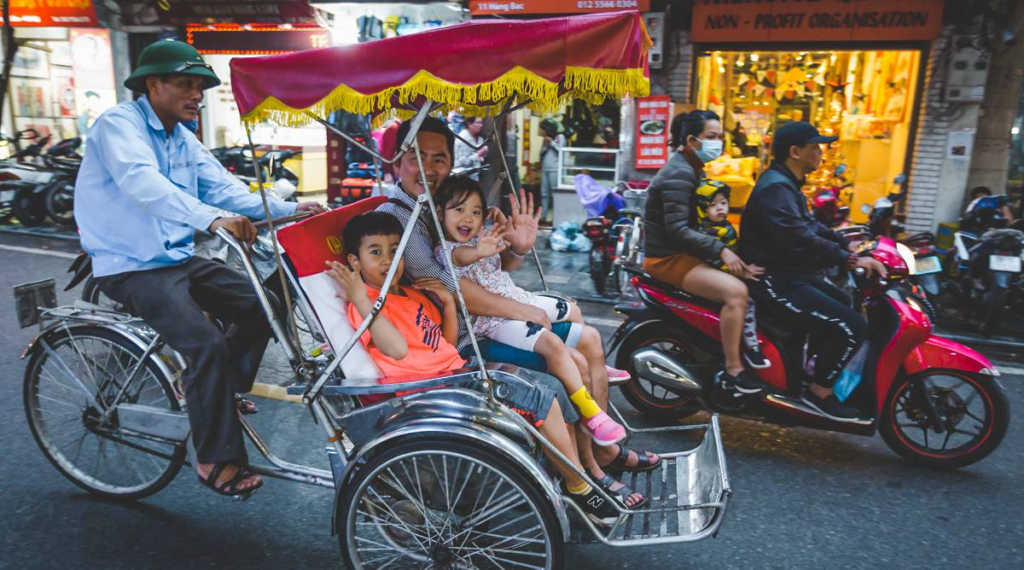
Only reserve a cyclo through your hotel or a travel agency if you are convinced that you want to ride one. Be absolutely explicit about the fee arrangement before you begin the ride. Make sure you comprehend the complete cost and everything it contains. It is important to be clear about your agreed fee, including whether it is per person, per hour, or a flat rate regardless of the number of persons or duration.
To assist avoid confusion, it can be helpful to put it in writing and confirm with the driver. Additionally, confirm that the total fee includes waiting time if you plan to use a cyclo throughout the day and the driver must wait for you while you explore.
3.4. Buying souvenirs
Everyone typically purchases gifts for friends and family while traveling. However, as the first prices quoted by the sellers are generally relatively high, please use caution while comparing the prices of these things.
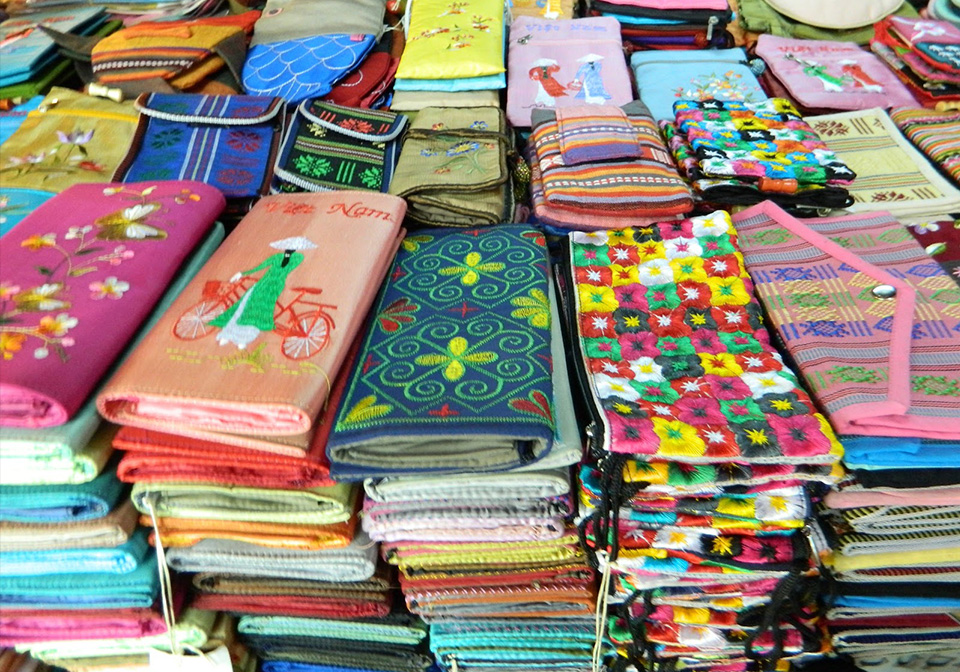
This occurs mostly in touristy areas like Hoi An, Hanoi’s Old Quarter, and the passageways surrounding Ben Thanh Market. or other gift stores at tourist destinations. Consider pricing negotiation to be a game. Whoever negotiates most successfully wins. You should haggle costs down to between 50 and 60 percent of the initial pricing if you want to get mementos from there.
3.5. Taking photos with street vendors
Just be quick and discrete when snapping images of individuals, especially street vendors. As per typical, street merchants will inquire as to whether you’d like to use their Non La (conical hats) and bamboo baskets for any picture sessions. There are now two scenarios that could occur:
- To get photos shot using these distinctive photo props, you must pay.
- You can snap pictures for nothing. Instead, they will compel you to make a purchase in support of some of the things they are promoting.
You should be quite firm while negotiating costs. Be prepared for some shouting and a crowd of individuals that don’t treat foreign tourists with any consideration while fooling the locals.
Here are some pointers:
- Utilize your smartphone to stealthily take pictures.
- Avoid speaking with them or using their supplier for a photo shoot.
- Just leave and look for Circle K stores to buy coconuts.

3.6. Selling bird-toys
Some street merchants use the “selling of bird toys” as a tourist trap, especially in Hoi An. They are produced by hawkers who frequently bring vibrant bird toys to Hoi An. To draw tourists’ attention, they fire them into the air. They then haggle for a very high price when outsiders offer to buy. The cost is currently between 200,000 and 300,000 VND per unit. You can, however, haggle for cheaper costs, such as 50,000–100,000 VND.
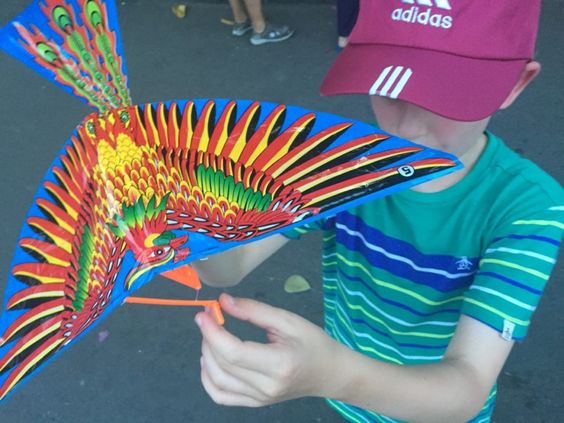
3.7. The two-shine
The “two-shine” is another typical tourist trap in Vietnam. Please be prepared to be pursued by shoe shiners if you are wearing dress shoes, leather shoes, boots, or any other nice shoes in a touristy area. Foreign visitors frequently reject these services.
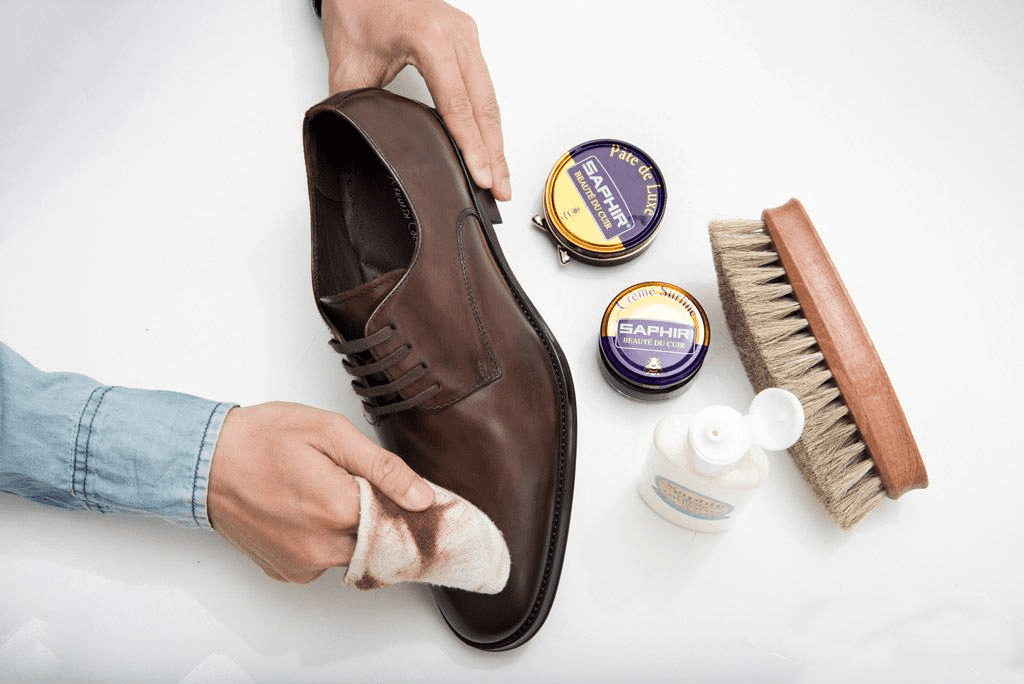
However, youngsters under the age of 12 make up the bulk of shoe shiners. They have burnt skin, are tiny, and have a very unattractive appearance. Of course, these pitiful images affect the majority of us. They will want a fair price to polish your shoes.
But the cost had doubled when they came back. The price was only for one shoe, which was the main factor. The cost of shoe shine and slipper repair can range from a few hundred to a million VND, preying on international tourists who have poor communication skills and little information. Visitors who wish to avoid trouble should “shut their eyes” and pay.
My real advice is still to NOT debate if you want to. Please be calm and believe in me! Because muscle gangsters from the underworld may always be found nearby. Visitors are advised to politely decline the invitations. Visitors should alert the local authorities in the event of coercion.
3.8. Playing blackjack with Filipinos
It would be dreadful to miss this tourist trap—the Filipino blackjack scam—when returning to Ho Chi Minh City, often known as Saigon. The intention of the con artists is to capture international visitors who are traveling alone and have recently arrived in Vietnam.
Many visitors have complained that the gang is an annoyance even though the majority of tourists who are solicited refuse to join the con artists. You will play blackjack and will either win or lose depending on their wishes if you accept the invitation, though.

You will initially receive some winning strategies. Actually, you can triumph! The sum of the bet will then finally exceed what you have. A person who had previously agreed to be your “secret partner” winks at you at this point and offers to loan you the money you need.
You find it tough to pass up “this opportunity” when you have the mindset of a perpetual victor. You have just now to waste! The bigger issue, though, is paying back the money you just borrowed.
What are your thoughts on this fraud? Isn’t it simple to be taken advantage of? Therefore, if you wish to avoid them, just turn around when they approach and go away.
There are several frauds you need to be aware of. In actuality, tourist traps are a typical feature of all attractions. You might learn more about sharing with friends and family as a result. However, there are also feelings of uneasiness, discontent, and mild wrath present. Therefore, avoiding tourist traps and frauds is the best approach to have a fantastic trip in Vietnam.
You should thoroughly review my article and, if necessary, make notes. Additionally, the following hotlines are recommended for you to be aware of before visiting Vietnam:
- 112 – Emergency rescue
- 113 – Police
- 115 – Ambulance
- 024.3.94.23760 – Vietnam National Administration of Tourism
- 1080 – General Information Service
- 1088 – Consultancy Service
- 1081 – Yellow Pages Information and Consultancy Service
It is also smart to get assistance from embassies. I’ll end by wishing everyone visiting Vietnam from abroad a wonderful experience. You are always wecomed to Vietnam!
You Might Also Like
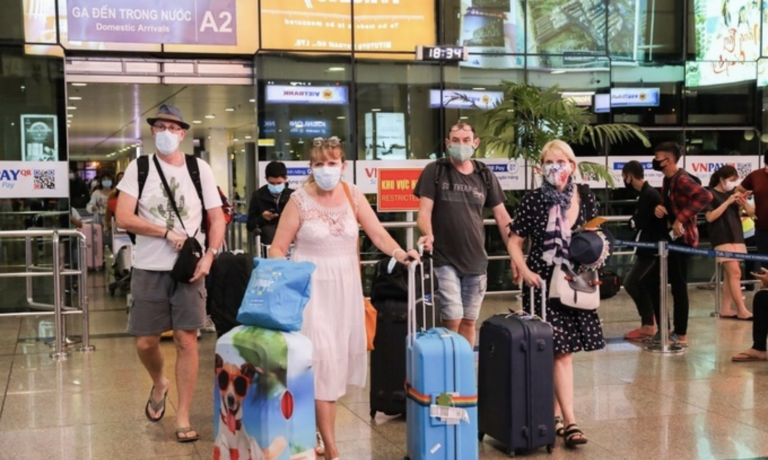
A Guide To The Best Vietnam Airlines For Domestic Flights (Update 2023)

7 Tips to Communicate with the Locals in Vietnam
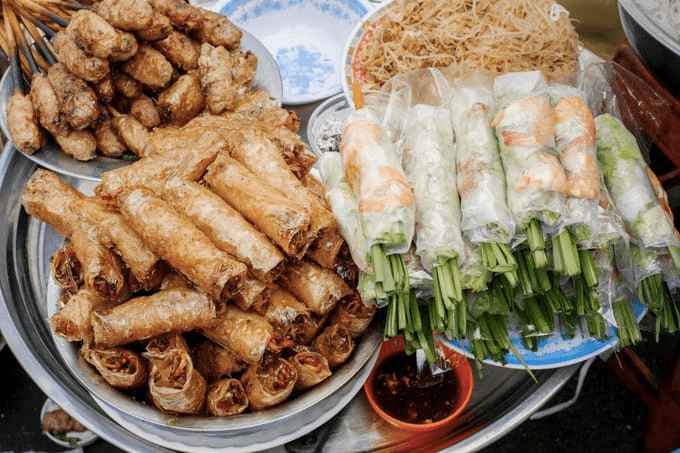
14 Of The Vietnam’s Must-Try Snacks
Cu Chi Tunnels: Tourist trap or not & The secret entrance
- Ho Chi Minh City
The Cu Chi Tunnels are one of the most famous attractions in Vietnam. Not only is it a special location, it is also a location with an extraordinary story. The Cu Chi tunnels are the infamous network of underground tunnels in the Cu Chi region. These tunnels are only part of a gigantic tunnel system that runs through the entire country. The tunnels were used by the Vietnamese soldiers during the Vietnam War.
Are the Cu Chi tunnels worth a visit? Definitely! It is one of the best things to do in Ho Chi Minh City . Here you can read everything you need to know about the tunnels: history, facts, how to get there and whether you should visit Ben Dinh or Ben Duoc.
History of the Cu Chi Tunnels
Ben dinh or ben duoc – the secret entrance, how to get to the cu chi tunnels, opening times and admission prices, a visit to the cu chi tunnels, shooting range.
- Travel tips
Alternative
It was Ho Chi Minh, the leader of North Vietnam, who in 1965 ordered the expansion of the existing tunnel complex and turned it into a shelter for communist rebels from the south, the Vietcong and the North Vietnamese army. The most important point of this tunnel complex was in the Cu Chi region. The tunnels extended at least 300 kilometers! In addition, the tunnels had multiple levels that were interconnected and tunnels with traps. Some tunnels were up to 13 meters deep.
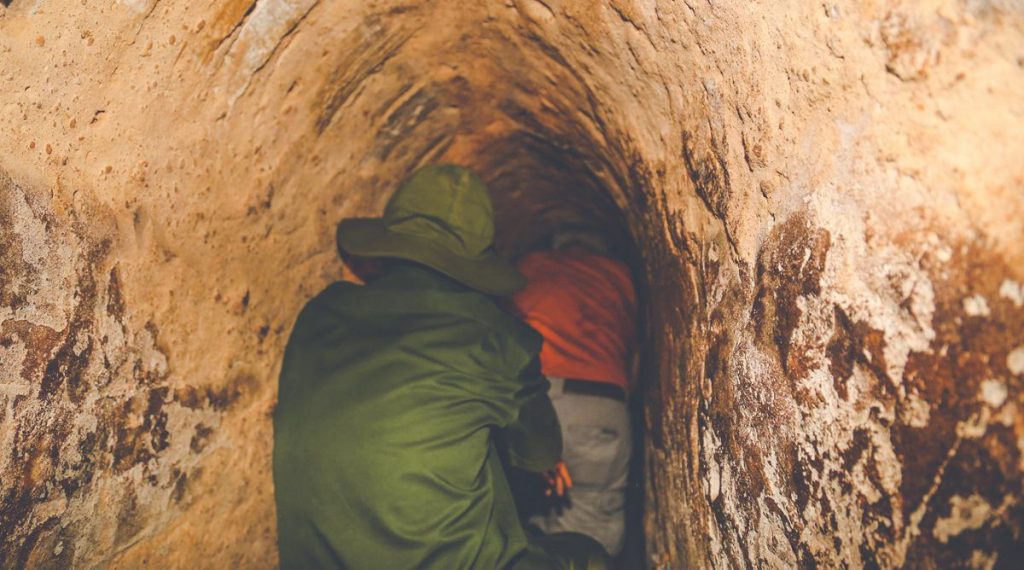
The construction of the tunnels are very special. There are many bends for protection against explosions and passages in a U-shape that were filled with water. This was to protect against toxic gases. Moreover, the tunnels were very narrow, so that the Vietnamese could easily get through, but not the Americans. Many animals from the jungle also used the tunnels as hiding places, making it even more dangerous. In the tunnels entire villages were reconstructed, including ammunition depots, hospitals with operating rooms, bedrooms, meeting rooms, food storage areas and even theaters.
Many Vietnamese stayed in the tunnels all day long to come out at night to fight. This led to success in the war and confused the Americans because the Vietnamese disappeared like ghosts in the tunnels. However, it also led to health problems due to the living conditions in the tunnels and the lack of sunlight.
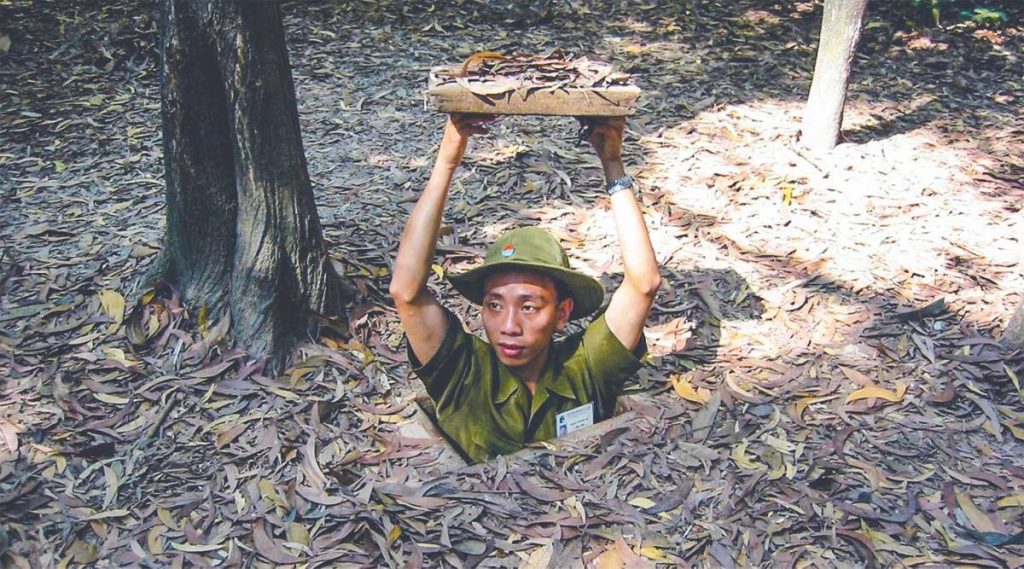
There are two areas where you can see the tunnels, Ben Dinh and Ben Duoc. Ben Duoc is the best example of the original tunnels. Ben Dinh also has tunnels, but they are all widened for tourist purposes. The entrance to the Ben Dinh is also closer (about 50 km from Ho Chi Minh City) and is a more convenient option, but does not offer the same experience. Due to the shorter distance to Ho Chi Minh City, this location is more touristy and also the main choice of most of the the Cu Chi Tunnel tours that depart from Ho Chi Minh City, so you have a less authentic experience. Ben Duoc (about 70 km from Ho Chi Minh City) is recommended if you have more time.
A private or group tour is the easiest way to visit the tunnels from Ho Chi Minh City . You have different choices, with a bus, limousine minibus, car and even with a boat.
Cu Chi Tunnels by motorcycle or car
Most tour companies arrange tours to the Cu Chi tunnels by motorcycle, car or bus. It takes approximately 1.5 hours to reach the tunnels at Ben Dinh. Try to avoid large bus trips. Try to avoid large bus tours. In these very cheap tours from $ 5, you travel with a very large group, so you have little time to see everything and only transportation is included, so no lunch and entrance to the tunnels.
Cu Chi tunnels by boat
If you are interested there are a number of boat trip services that will take you to the Cu Chi tunnels.
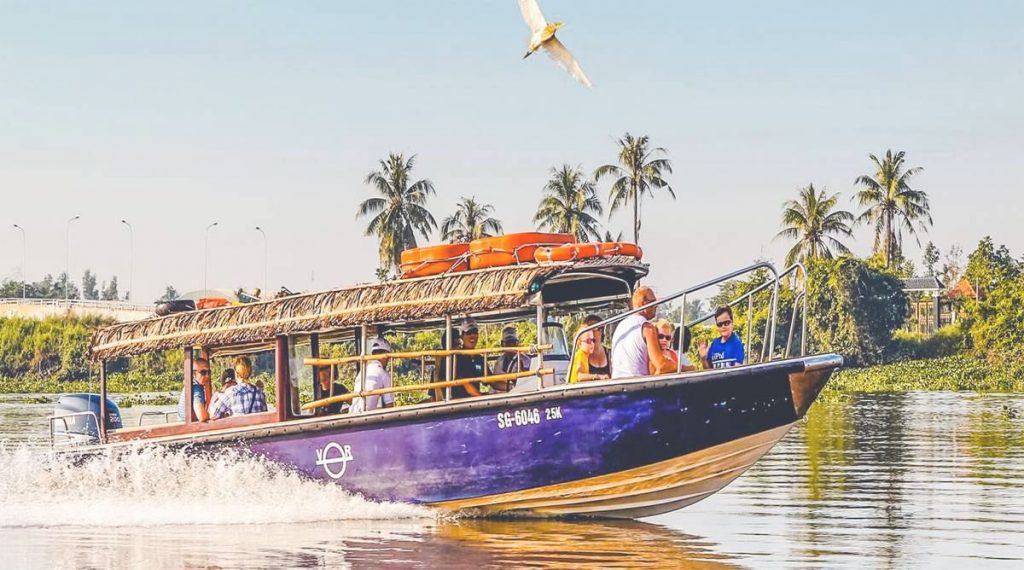
Cu Chi tunnels by taxi
You can also take a taxi to the Cu Chi Tunnels, but this is very expensive. And a real waste, because you can’t get anything else out of it. You can expect to pay around $ 60 for both directions, as it is a 120-kilometer journey.
Cu Chi tunnels with the public bus
You can also take the public bus to the Cu Chi tunnels. You only have to take two buses to get to Ben Duoc. First, take bus # 13 from 23-9 Park (near Pham Ngu Lao – the backpacker area) to the Cu Chi bus station. Then take bus # 79 towards Ben Duoc. The total travel time in this way is around 2.5 hours and the price will be around 26,000 VND (just over $ 1).
Both the entrance to Ben Dinh and Ben Duoc have the same opening times, but have different admission prices.
Opening times : daily from 8:00 AM to 5:00 PM
Entrance fee
- Ben Dinh: VND 110,000 per person
- Ben Duoc: VND 90,000 per person
The cheap backpacker tours to the Cu Chi Tunnels don’t include the entrance ticket to the tunnels, but all the regular tours do include entrance fees.
The Cu Chi tunnels now serve as a museum. Many tourists come to this place. Still it’s worth it. Especially the horrible booby traps are really interesting to see. The tunnels have been widened to make it accessible to tourists. Although it is still tight. Weird to see the small, long tunnels, where so many Vietnamese have lived underground for years. A must-see for anyone who wants to know more about the (horrific) history of Vietnam!
An underground guided tour takes about 45 minutes to an hour and consists of a number of impressive demonstrations and stories.
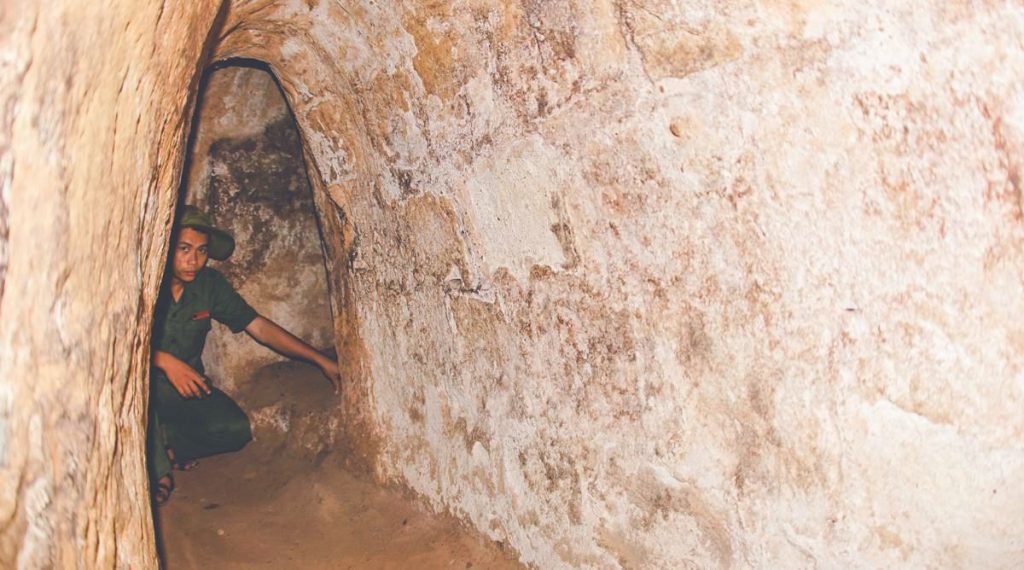
During your visit to the tunnels you can get a reasonable picture of the harsh living conditions and how people used to operate here. Especially the booby traps make an impression, because they are very inventive and at the same time very horrible to see. Concealed hatches lead to sharp pins, intended to injure and deceive the American enemy. A guide will be happy to tell you how these techniques were used and why.
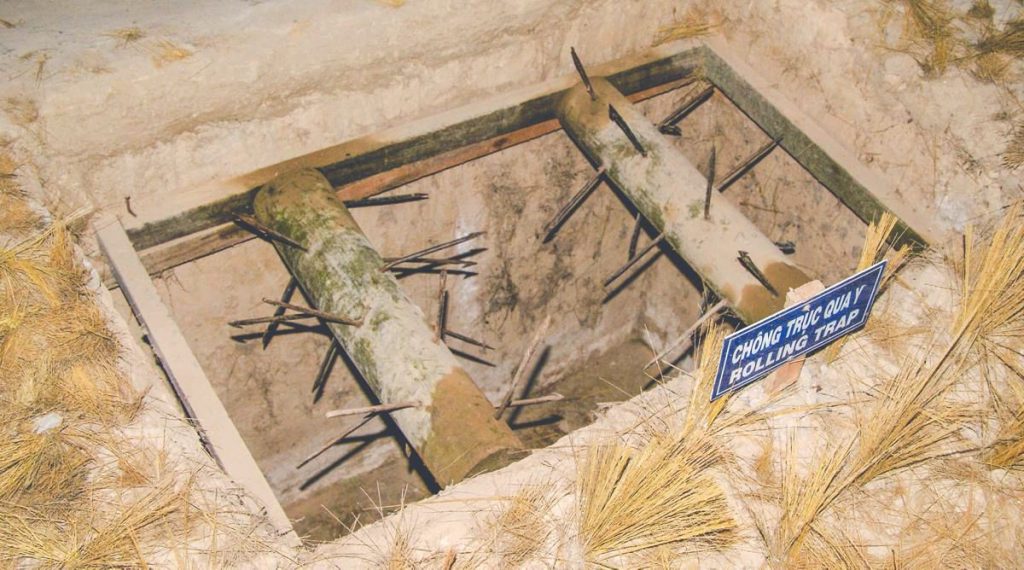
There are a number of things you can do at the Cu Chi Tunnels. Explore the area, crawl through the tunnels, watch documentaries, exhibitions, traps, take photos and of course shoot with a gun!
Both Ben Dinh and Ben Duoc have shooting ranges for tourists. The conditions are that you are in good health and at least 16 years old to participate in this activity.
The balls are sold in sets and each set has about 10 balls of the same type. Here is the price list for different types of bullets that are sold:
- M16: 35,000 VND / 1 bullet (~ $ 1.6 USD)
- AK 47: 40,000 VND / 1 bullet (~ $ 1.8 USD)
- M60: 40,000 VND / 1 bullet (~ $ 1.8 USD)
- Garand: 30,000 VND / 1 bullet (~ $ 1.4 USD)
- M30: 30,000 VND / 1 bullet (~ $ 1.4 USD)
- CARBIN: 25,000 VND / 1 bullet (~ $ 1.1 USD)
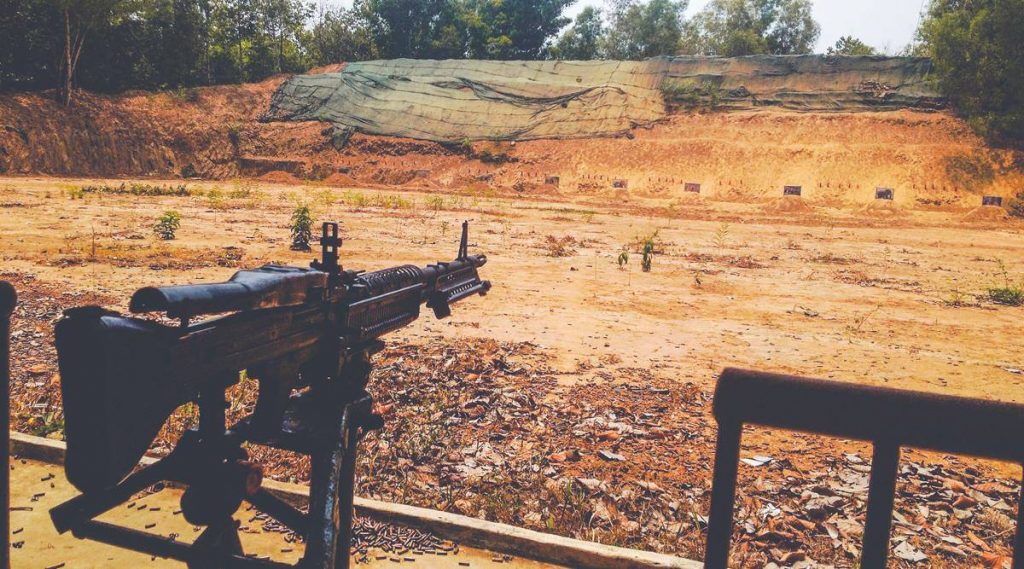
- There is no dress code for the Cu Chi tunnels, but wear something that you don’t mind getting dirty because you go underground.
- A comfortable pair of sneakers is a good idea.
- Sunscreen and insect spray can be handy to take with you.
- The Cu Chi tunnels are open during the rainy season (May to November) and there are no floods in the tunnels, but the experience may be a little less comfortable.
- During Tet (Vietnamese New Year, which falls in late January or early February), the tunnels are still open.
- Tourists with claustrophobia are not advised to go into the tunnels. You can still visit other places and enter the larger excavated places.
The Cu Chi tunnels are the best known remaining tunnels of the Vietnam War. The tunnels are often visited for this and it can be busy with many tourists. The Vinh Moc tunnels are a good alternative, located near Hué. The experience here also feels more authentic than the Cu Chi tunnels.
- Mekong Delta
- Language & travel dictionary
- Electricity
- Internet & calling
- Best travel time & weather
- Hoe does it work?
- Visa on Arrival
- Visa at embassy
- Holidays & Events
- People & minorities
- Flights to Vietnam
- Domestic flights
- Motorbike buy/rent
- Train travel
- 15 most beautiful destinations
- 20 best things to do
- 10 best off the beaten track
- 10 most stunning beaches
- 10 best rice fields places
- 10 best adventures
- 10 cultural experience
- All travel inspiration
- Package trips
- Custom made trip
Local tip! You might like these experiences

Cu Chi Tunnels half day deluxe tour
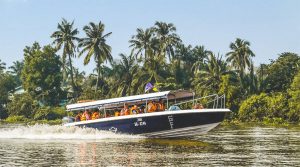
Cu Chi Tunnels tour by speedboat
- Destination: Ho Chi Minh City
- By: Marnick Schoonderwoerd
- August 20, 2019
- No Comments
Leave a Comment Cancel Reply
Your email address will not be published. Required fields are marked *
Save my name, email, and website in this browser for the next time I comment.
- Destination Guide
- Essential Guide
- Getting Around
- Vietnam Month by Month
- Inspiration
- Vietnam blog
- Custom Made Trip
- Day- & Multiple Day tours
- Holiday Packages
- Local Meo Vac Homestay
- Local Dong Van Homestay
- Our Team & Company
- Our Customers & Reviews
Copyright © 2023 Local Vietnam
Start typing and press enter to search
Free ebook vietnam travel guide.

- My Interests
Top Stories
Meet sophia tatum: all about samaritan’s sil, looking for real life treasures here’s 7 places you should visit for treasure hunting, everything we know about tate donovan’s ex-wife corinne kingsbury, stay connected, 7 tourist traps in vietnam that you should avoid.
Vietnam is generally safe for tourists but does have some scams. As with many destinations worldwide, there are some pitfalls to be wary of as a tourist. Here’s a list of seven common traps to ensure your trip remains a positive and memorable experience.
7. Street Vendors
Vietnam’s streets have many vendors selling various products, from local delicacies to handcrafted souvenirs. However, some street vendors, particularly in tourist-heavy areas, might employ tactics to lure unsuspecting travelers.
For instance, they might pressure you into buying something, or the quality of products might not match the price. Another common scam involves taking pictures with fruit stalls or bicycles, followed by demands for payment or forced sales. Tourists might either be asked for money post-photo or be sold the fruit/coconut at an inflated price.
6. SIM Card Fraud
Buying a local SIM card can be incredibly beneficial for tourists, but be wary of where you purchase. There have been reports of travelers being sold already-used or expired SIM cards. This scam is even present at airports. To avoid this, it’s recommended to buy SIM cards from official stores of reputable telecom companies.
5. Motorbike Rental
Be cautious while renting a motorbike: there are rental shops known to rent out bikes in poor condition or claim damages upon return that were pre-existing. Before you rent, inspect the motorbike thoroughly and take photos of any existing damages.
Another scam involves motorbike rental staff stealing their own bikes from renters, who are then forced to pay huge sums. Besides, a valid driving license is necessary, though some shop owners may say otherwise.
4. ‘Free’ Squeaky Donut
The squeaky donuts are popular among street food vendors. Some vendors, however, might offer them for ‘free’ and later demand payment, causing an unpleasant surprise. On the other hand, the oil used for frying these donuts can be unregulated and unsanitary. Consuming these donuts has made some travelers sick.
3. Unexpected Luggage Handlers
At bus stations or other transit points, you might encounter individuals rushing to help you with your luggage, only to ask for a fee afterward. While it might seem like a kind gesture initially, it’s best to handle your belongings yourself or agree on a price in advance if you do need assistance.
Some bus staff might falsely claim a baggage fee, but there is no official baggage fee in Vietnam.
2. Fake Taxis
Fake taxis, or those not associated with taxi companies, can sometimes overcharge or take unnecessarily long routes. Some taxis imitate licensed cabs, attracting tourists with false promises. They can overcharge or even rob passengers. To ensure a safe journey, always opt for reputable taxi companies. Using ride-hailing apps, where available, can also be a reliable option.
1. Overcharging For Almost Anything
Perhaps the most common trap tourists face in Vietnam is overcharging. Tourists might be given less change or told they owe an obligatory tip. From restaurants to souvenir shops, always be sure to check prices in advance or compare with similar others. Familiarizing yourself with the local currency and having an idea of standard prices can help you avoid potential overcharges.
From Justin Bieber To Mila Kunis: 7 Celebrities Who Booked Their Spot For A Space Trip
All about halston sage’s departure from the orville.
Sign in to your account
Username or Email Address
Remember Me
cassiethehag
Vietnam backpacking route – 1 to 2 itinerary
Below is my suggested Vietnam backpacking route based on travellers who are looking for a one to two-week Vietnam itinerary. Vietnam is full of stunning nature, historical sights and helpful locals. You’re sure to have a wonderful time backpacking through Vietnam, and I hope these travel tips help you plan a fantastic trip!
Please note that this blog post most likely contains affiliate links to products or services I use and love! If you click on the links, it means I get a little extra pocket money at no additional cost to you. This is what keeps my website ticking over – thank you!
Getting around Vietnam:
It’s so easy to backpack around Vietnam! You can access the first point on this itinerary from Hanoi (Vietnam’s capital city) by direct bus. You can always book night or day buses directly from your accommodation to your next stop. It is honestly the most accessible country I have ever travelled in, and accommodations are used to speaking English to tourists.
Whilst visiting each stop, you can rent a scooter or hire an easy rider (a Vietnamese guy who’ll take a round on his motorbike – great fun). Many places also had bicycles to rent or borrow – and you could walk too!
Table of Contents
Vietnam backpacking route (1-2 week itinerary)
Fly into hanoi.
Before we begin, it’s worth noting you will probably fly into Hanoi to begin your Vietnam adventure. Two popular activities are Halong Bay and Sapa. However, the first is exceptionally overcrowded. Although stunningly beautiful, Sapa has been noted by many as having lost its authenticity.
Should you wish to visit Halong Bay, I recommend taking the less crowded but equally beautiful Cat Ba Island route.
You could also consider Mai Chau as an alternative to Sapa. It is half the distance from Hanoi than Sapa, and you can still walk the rice fields. Or, like myself, you could simply go South to Ninh Binh below.

After arriving in Hanoi – the capital city of Vietnam – the easiest way to Ninh Binh is by bus. The bus takes around 3 hours and costs around 10 USD.
Ninh Binh is known as ‘Halong Bay on land’ but with fewer tourists (though I suspect that’ll change soon). You access Ninh Binh on a direct bus from Hanoi or Halong Bay. It’s recommended you stay in Tam Coc or Trang Na – don’t stay in Ninh Binh city, as it doesn’t have the same gorgeous scenery. From your accommodation, you can rent a bicycle or scooter – or you can walk like me!
Things to do in Ninh Binh, Vietnam
Hang mua caves.
Tipped as the best Vietnam view, who am I to argue? Easily accessed by bike or walking, it’s a fantastic attraction with a stunning staircase carved into the looming mountains. There are almost 500 steps, so be prepared, but it’s totally worth it.

TAM COC BOAT TOUR
If you’re keen to see the mountains looming out of the water, go on a boat ride where the locals row with their feet! Or an alternative is also the TRANG AN GROTTOES TOUR.
BICH DONG PAGODA
An ancient pagoda. It was flooded when I went, but I felt this only added to the experience and made it extra unique.

EXPLORE THE DIRT ROADS AND FARMS TRACKS
Ninh Binh is a natural wonder best enjoyed at your own pace. Since I couldn’t ride a bicycle, I walked 20km the second day, armed only with a playlist, and loved every minute of it. For those cycling, check out the Homestay Loop – ask about your accommodation, as many provide maps, or look on google maps. Honestly, on the dirt tracks, I saw NO ONE else. Very tranquil.

Phong Nha was one of the most heavily bombed areas during the Vietnam War because it was part of the supply route from North to South Vietnam. People hid in caves during the day and did all the work at night, even farming. It is now a peaceful place, surrounded by gorgeous nature and with a surprisingly good tourist infrastructure in place.
Hiring an easyrider in Phong Na for one day was 11 pounds. I asked my hostel Easy Tiger to help. You can rent your own for less money, giving you more freedom.
Alternatively, you can borrow a bicycle from your hostel. This is only recommended for stops which are near the main town. Exploring the National Park itself – including key locations such as Paradise Cave – is recommended on scooters due to the long distances and hilly roads.
Things to do in Phong Nha , Vietnam
Paradise cave.
The cave was discovered in 2005 by the British cave association. 1km of the massive 36km cave is open to tourists. No list of things to do in Phong Nha would be complete without this mighty cave network!
The walk up to the cave entrance is steep. It has a well-made sloping footpath or steps, but you can also get a buggy each way for 10K.
This place has to be seen to be believed. I’ve seen a LOT of caves while travelling, and frankly? This one ruined all the others for me! It really is like walking into another planet – the most otherworldly place I’ve experienced. Unfortunately, I found it very hard to photograph – the scale of it is beyond what my camera can take in.
The limestone formations loom all around the wooden boardwalk, and the artificial lighting creates an increasingly mystical effect.
Entrance cost: 250,000 VND per person

PHONG NAH CAVES BOAT TOUR
It was strange to think of people hiding in the caves during the war whilst bombers outside targeted the entrance to the cave. They even had to bring the supply bridges inside the cave during the daytime! The stalactites and stalagmites were incredible, like ominous giant jellyfish.
These caves are close to the main town – in fact, you may even be able to walk there from your hostel. So whilst it’s not as spectacular as the other caves, it’s still a beautiful spot perfect for when you have a couple of hours free.
Entrance fee: 150,000 VND
DARK CAVE (HANG TOI)
This is a more ‘activity-based’ cave experience in which you zipline or kayak into the cave and walk through deep mud wearing a headlamp. Apparently, all that mud is good for your skin, though; who knows? They say only bring clothes you don’t mind getting ruined (nothing white).
The reviews are pretty mixed, with some calling it a tourist trap and others saying it was loads of fun. Maybe it depends on how fun you find mud.
Entrance fee: 250,000 VND (low season) or 450,000 VND (high season)
HIRING A SCOOTER OR EASY RIDER TO TAKE YOU AROUND PHONG NHA-KE BANG NATIONAL PARK
The loop is scenic and gorgeous! It’s a fantastic way to see some of Vietnam’s best landscapes, still untouched by the swarms of tourists surrounding other areas such as Ha Long Bay. Along the way, you can make stops at Paradise Cave, the Botanic Garden, the Dark Cave and more.
PHONG NHA BOTANIC GARDEN
Entering through a jungle forest, Phong Nha Botanic Garden is wilder than any other I’ve been to. Most guests will pick from a short 1-hour or longer 3-hour loop from which to walk around the ‘garden’ – don’t expect any flower displays or cute fountains
There’s a waterfall you can swim in, but the descent is not via a proper footpath – instead, you’ll be scrambling over slippery rocks. I wasn’t really prepared for this short but challenging hike down – you’ll need trainers or hiking shoes, not flip-flops. The viewpoint (pictured below) was very pretty.
Remember your mosquito spray for this activity, or prepare to get bitten. 🙂 I also ate lunch at the restaurant here – just vegetable noodles.
Entrance fee: 40,000 VND

GRAB A BICYCLE AND HEAD TO ‘DUCK STOP’…
‘Duck Stop’ is literally a place where a guy owns lots of ducks and gives feed to tourists, so the ducks all run at them. Sound weird? It’s one of the top-rated attractions in Phong Nha, with glowing reviews all around. If you fancy a giggle, it’s the place to go.
The activity is run by a local family and offers endless ridiculous photo opportunities.
Entrance fee: 150,000 VND (includes a pancake and drink)
…& PUB WITH COLD BEER
At the same time, you can head to ‘Pub with Cold Beer.’ Apparently, it got the name after some tourists got sick drinking beer with ice on a hot day (the water is not drinkable in Vietnam) so a fabled local one day bought a fridge! Thus, the Pub With Cold Beer was a must-visit for any tourists who fancied a drink.
Backpacking Accommodation in Phong Nha:
Easy Tiger is an excellent hostel in the heart of Phong Na – and you can take advantage of it even if you don’t stay there. For people staying, it had a jungle theme and pool and loads of food options on sight. But best of all, every morning at around 09:15, they do a talk about everything there is to do in Phong Na – and everyone is welcome! They encourage backpackers to share costs, making it easy for me as a solo. They will tell you all the activities and how to get to them and provide maps along with the best places to hire scooters or bicycles.
Many people don’t rate Hue, but I think this is down to the lesser-known sights (except perhaps the highlight below). It is home to the Imperial City – part of its vast, 19th-century citadel, full of shrines and palaces – and the Forbidden Purple City. Despite so many beautiful attractions, it was disturbingly also where the Battle of Hue took place – in 1968, thousands of people were killed.
Read more: Is Hue worth visiting? Pros and Cons
Things to do in Hue
The abandoned waterpark.
Whilst there are loads of tales of people sneaking into the park and dodging security, I found it very easy to enter the park! I think it was super easy to get there because I had hired a local guide for the day (along with his scooter).
They spent 3 million US dollars to create the waterpark for families, yet now I was wandering around over barbed wire and broken glass. Although it’s not officially open to the public, everyone goes… A must-do unique experience for your Vietnam itinerary.

VONG CANH HILL LOOKOUT
Who doesn’t love a viewpoint? On the outskirts of the imperial city, Vong Canh Hill overlooked the serene Perfume River and was incredibly peaceful. The park here is a really lovely way to break up visiting busy tourist attractions.
A visit to the park or river is undoubtedly the most romantic way to escape Hue’s crowds and traffics. As well as being a welcome retreat from the heat.

TU DUC TOMB
Tu Duc is sometimes considered the last emperor of Vietnam and died in 1883. He had no children but 104 wives and even more concubines… sounds stressful, right? His tomb is, however, surprisingly tranquil, grand architecture scattered around a moat and lily ponds.
Noticed by many as being the most beautiful of the Nguyen emperor’s tombs, Tu Duc Tomb is highly recommended if you only have time to visit one. It is a vast and elaborate site which thus does not get too crowded.

PAGODA OF THE CELESTIAL LADY / THIEN MU PAGODA
The perfect way to end a day exploring Hue. My local guide (aka scooter driver) told me all about the folklore surrounding the temple and that it’s the tallest religious building in Vietnam.
IMPERIAL CITY
Hue is home to the Imperial City – a vast 19th-century citadel full of shrines and palaces – and the Forbidden Purple City. From 1802 – 1945, Vietnam was ruled by the Nguyen Dynasty, who had their capital here. This is where the many emperors once lived, crawling with history.
It’s worth noting that many buildings were damaged during WW2 and the Vietnam War, but enough remains intact to make it worth a visit nonetheless.
LEARN ABOUT THE WAR AT THE DEMILITARIZED ZONE
For a real insight into the divisions created during the war, visit the battleground demarcation line between the Communist North and free South that divided the country into 2 separate states.
HOI VAN PASS
I hired an easy rider for around $35 USD to take me on the 137km journey from Hue to Hoi An. This local guide was so friendly and made the day really enjoyable. This is a great way to travel from Hue to either Hoi An or Danang visa the spectacular winding mountain road.
Since the whole day was a highlight, I will simply list the stops in order:
Stops along the Hoi Van Pass:
A real-life gorgeous waterfall with man-made pools underneath. It was great to relax here for a bit, despite being very crowded, as it was such a hot day. A bizarre elephant statue is cut into the rock, and so many different pools of different sizes stretch up the mountain. Very touristy but bizarrely pretty fun!
LANG CO BEACH
Although it was mostly a seafood option, I found a veggie option. There wasn’t much there, but the beach was pretty and sandy. I was keen to move on, though, because the next stop was…
THE HOI VAN PASS
Of course, this 21km mountain pass was the highlight of the day! The views were incredible, and it felt great to feel the wind rushing past us as the bike scaled the winding roads.

MARBLE MOUNTAINS
After a refreshing ice cream break, I explored the inside of the mountain. There are creepy figures carved into the mountain that get more and more disturbing as you walk further in—quite an experience.

This was my last stop in Vietnam. I flew from here to Singapore after spending a few relaxing days strolling along the riverbank and enjoying the many glowing lanterns which line the old town. Hoi An is a popular spot for those staying in Vietnam long term due to its charming cafe culture and abundant local historic sights, and nearby beaches.

Things to do in Hoi An :
- eat outdoors on the bustling streets, admiring the lanterns. There are many cute cafes and both local and western-style restaurants to choose from.
- get clothes tailored! I got a couple of dresses made here, which was so much fun.
- go for a Vietnamese massage – honestly so cheap
- visit the old quarter
- See the Japanese bridge
- Try egg coffee – way nicer than I expected!
- Take a cooking class or cooking tour – my hostel held tours three times a week!
- cycle to the beach or take a boat trip to the highly recommended Cham Island
- Click here for a full three-day Hoi An itinerary.
CHAM ISLANDS
You should also consider staying with locals overnight on Cham Island! I spoke to other backpackers who found this an authentic and fun way to enjoy more of what Vietnam offers.
These beautiful islands are two hours boat ride from Hoi An and a perfect place for diving and snorkelling.
Visit MY SON CHAMPA RUINS – HOI AN
The Champa city of My Son was occupied from the 4th to 13th century. It was a dominant city for Cham people due to its defensible location and was an essential Hindu temple complex. The area was heavily bombed during the Vietnam War in 1969, and now just 18 of the approximately 70 structures documented initially remain. Landmines likely remain in the surrounding area – beautiful but dangerous and a reminder of this country’s tragic past.

How to tie this into a longer Vietnam itinerary:
GO NORTH : Those on a more extended trip can still easily access beautiful Sapa (to hike the rice fields), Halong Bay, motorcycle around Ha Giang, or spend 2 days in Hanoi before embarking on the following itinerary. I personally did Sapa, Hanoi and Halong Bay and was unable to go to Ha Giang.
GO SOUTH: This itinerary ends in Hoi An, but from there, you can easily go South and spend a day in Ho Chi Min City – definitely a good option for anyone interested in history. Add Mui Ne to your Vietnam itinerary if you’re after something unique (it has red sand dunes!), the An Giang Province or Dalat if you love nature.

TRAVEL SUSTAINABLY IN VIETNAM
To avoid using plastic bottles in Southeast Asia, I used a Water To Go bottle.
The filters used in their BPA free water bottles are created based on technology originally developed for the NASA space programme. These provide safe water from any non-salt water source in the world.
Read more on their website and use the code HAG15 if you like what you see to get 15% off.
VISAS FOR VIETNAM
Most travellers will require a visa to enter Vietnam, which you can organise in advance. Check below to see your requirements. I personally used and paid for the iVisa service in 2020, and it’s a website I would genuinely recommend.

Share this:
Hi, I'm Cassie, and I've been solo travelling the globe since May 2018. In this time, I've backpacked around Southeast Asia, Japan and The Balkans, alongside living in New Zealand and Australia. Current location? Mexico
What to read next

Is Hue worth visiting? Pros, cons & Hue travel tips!
Join the discussion cancel reply.
This site uses Akismet to reduce spam. Learn how your comment data is processed .

IMAGES
VIDEO
COMMENTS
3.6. Selling bird-toys. Particularly in Hoi An, the "selling bird-toys" is also a tourist trap besides the "taking photos with street vendors" trap. These are done by street vendors who usually bring colorful bird-toys to Hoi An. They shoot them into the sky to attract the attention of tourists.
Vietnam is a country that is relatively safe for tourists, but similar to most major cities there is the risk of traveller annoyances, such as petty crime and scams. Here are a few of the scams and tourist traps to be aware of to better enjoy the safe and awesome trip: Overview It is a good idea to inspect goods purchased, especially electronics.
Discover the real Vietnam by sidestepping tourist traps. Our guide reveals off-the-beaten-path gems, ensuring an authentic and unforgettable journey ... diverse landscapes, and time-honored traditions. The significance of steering clear of tourist traps becomes paramount as we aim to provide a genuine experience, allowing adventurers to connect ...
When it comes to exploring a new destination, the thrill of discovery and adventure is what often drives tourists. However, amid the excitement, there are pitfalls that can turn your dream vacation into a nightmare. In this article, we want to shed light on the issue of tourist traps in Vietnam and provide valuable insights on how to stay safe and avoid scams. So, let's dive into the world of ...
Australian Geoff Holland who used to live in Vietnam for three years also shared his experiences, warning people about the "tourist traps" one can encounter while in the country. Holland said was often a victim of taxi scams as a driver would charge him double the meter fare. He advised people to the install Grab app after arriving in Vietnam.
Today, we turn our attention to Vietnam, where foreign tourists share their experiences and offer advice on avoiding falling into tourist traps. Let's take a closer look. Many foreign tourists have taken to social media to share their experiences of being scammed while visiting Vietnam and to warn others about the potential pitfalls.
Vietnam offers a captivating blend of natural beauty, rich history, and vibrant culture that attracts millions of tourists each year. While exploring this Southeast Asian gem, it's important to be aware of potential tourist traps and scams that can dampen your travel experience. In this comprehensive guide, we present insider tips from seasoned travelers who have shared their cautionary tales ...
The following tips can help you avoid Vietnam's main tourist traps… Mekong Delta tours. The Mekong Delta region is a vast maze of rivers, rice paddies and riverine islands in southern Vietnam. The typical way to visit is with organized trips, either day-trips from Saigon or 2-day tours.
Vietnam - The Scams and Tourist Traps in Vietnam. Vietnam is a beautiful country that is safe for tourists, but like any other country, it has its share of scammers, who target innocent tourists. Visiting any country for the first time definitely comes with a learning experience, be it good or bad. Not knowing the local customs and language ...
3.7. The two-shine. One of the other common tourist traps in Vietnam is "the two-shine". If you are in a touristy area and wearing dress shoes; leather shoes; boots or whatever fancy shoes, please prepare to be hounded by shoe-shiners. Oftentimes, foreign tourists refuse these services.
We spent 18 days in Vietnam with our son. We established a base for each area we planned to cover and visited the surroundings from there, as follows: Hanoi (3 days) Tam Coc (3 days) Hoi An (5 days) Ho Chi Minh City (4 days) Can Tho (3 days) We were flying between the main regions (Hanoi-Da Nang-Ho Chi Minh), took the train from Hanoi to Ninh ...
Curious about Vietnam's best scenic routes? In this video, we uncover the truth behind these routes or whether they are tourist traps. We also check out the ...
Consider when you travel. Meaningful interactions can be had at quieter times of day and year, as a dawn visit to St. Peter's Basilica in Vatican City with an infant once taught me. "Traveling in the low season," Roca says, "will help avoid both tourists and traps alike.". Tim Chester is a deputy editor at AFAR, focusing primarily on ...
Therefore, avoiding tourist traps and frauds is the best approach to have a fantastic trip in Vietnam. You should thoroughly review my article and, if necessary, make notes. Additionally, the following hotlines are recommended for you to be aware of before visiting Vietnam: 112 - Emergency rescue. 113 - Police.
Alternative. The Cu Chi tunnels are the best known remaining tunnels of the Vietnam War. The tunnels are often visited for this and it can be busy with many tourists. The Vinh Moc tunnels are a good alternative, located near Hué. The experience here also feels more authentic than the Cu Chi tunnels. Ho Chi Minh City.
Here are a few of the scams and tourist traps to be aware of to better enjoy the safe and awesome trip: How to Avoid Scams and Tourist Traps in Vietnam | Vietnam is a country that is relatively safe for tourists, but similar to most major cities there is the risk of traveller annoyances, such as petty crime and scams.
Edit: I know that near my home there are a lot of "tourist attractions" that I wouldn't recommend to anyone. They are mostly designed to make money and don't offer much of a local experience or any other value. For some reason these types of places keep attracting tourist. I was hoping someone could steer me away from such places in Vietnam.
Vietnam is generally safe for tourists but does have some scams. As with many destinations worldwide, there are some pitfalls to be wary of as a tourist. Here's a list of seven common traps to ensure your trip remains a positive and memorable experience.Contents7. Street Vendors6. SIM Card Fraud5. Motorbike Rental4. 'Free' Squeaky Donut3. Unexpected […]
Welcome to Vietnam Untold. Today, we turn our attention to Vietnam, where foreign tourists share their experiences and offer advice on avoiding falling into ...
Alternative 1 - 2 Week Vietnam itinerary - Backpacking Vietnam beyond the tourist traps - things to do in Ninh Binh, Phong Nha, Hue, the Hoi Van pass, Hoi An and more. ... with some calling it a tourist trap and others saying it was loads of fun. Maybe it depends on how fun you find mud. Entrance fee: 250,000 VND (low season) or 450,000 VND ...
Vietnam is a captivating destination known for its rich history, vibrant culture, and stunning landscapes. However, like any popular tourist spot, it is not without its share of scams and tourist traps. This guide, titled "Warning about Tourist Traps," aims to equip travelers with the necessary knowledge to ensure a hassle-free journey.
If you are planning a trip to Vietnam, you are probably going to find a lot about Hoi An. Because of its small town feel, beautiful markets, and lively night...
Sapa - A tourist trap. We thoroughly enjoyed the natural beauty, but unfortunately, the city proved to be a tourist hotspot with limited attractions. The locals were notably less friendly compared to our previous experiences in Vietnam. Additionally, it was disheartening to witness young children, aged 3 to 5, selling souvenirs to tourists on ...